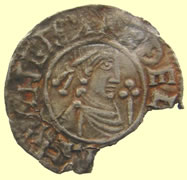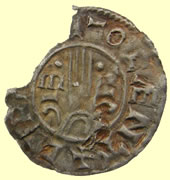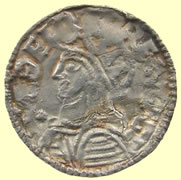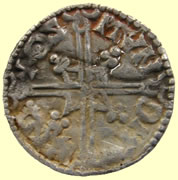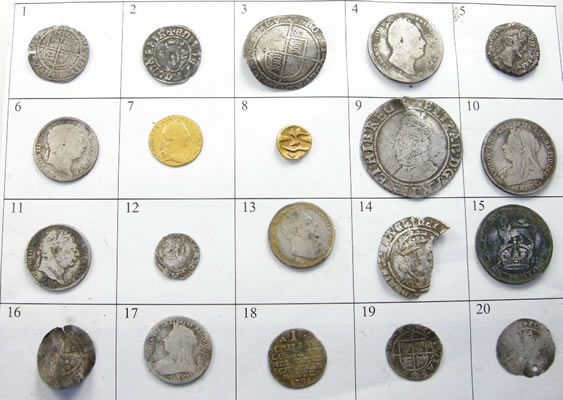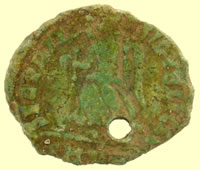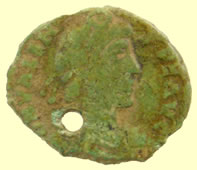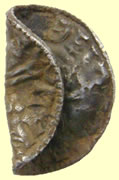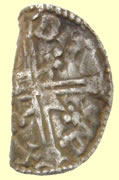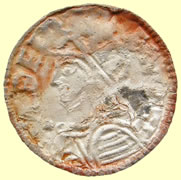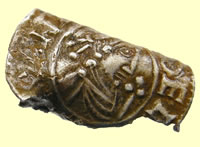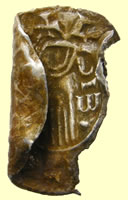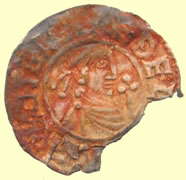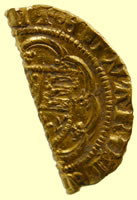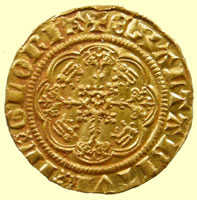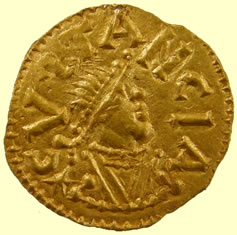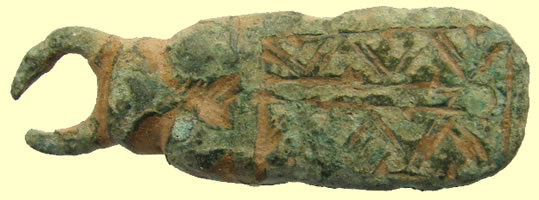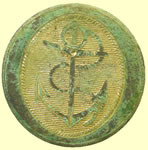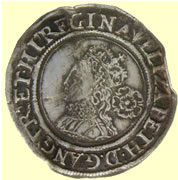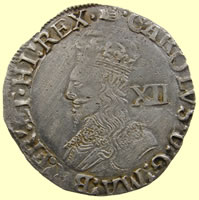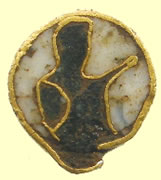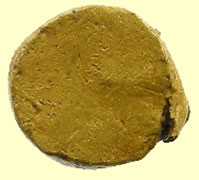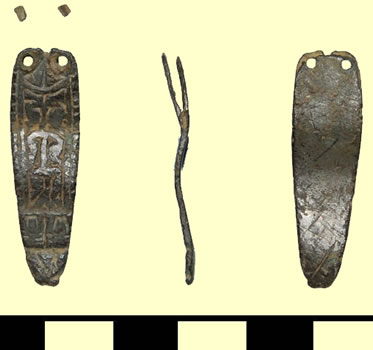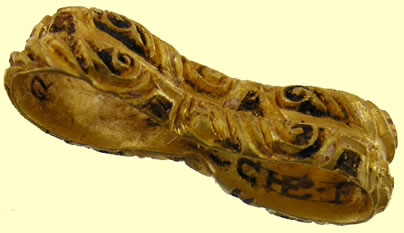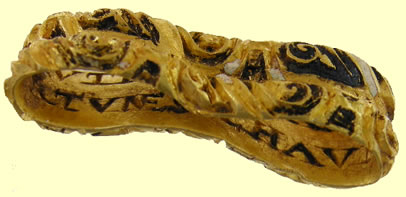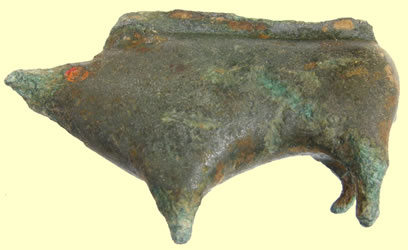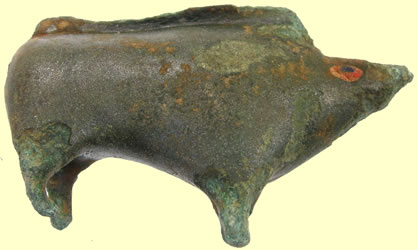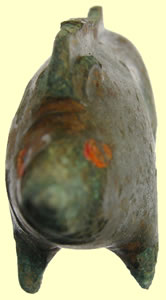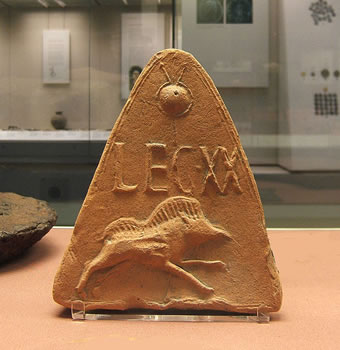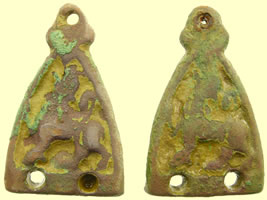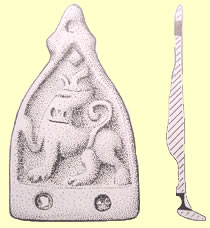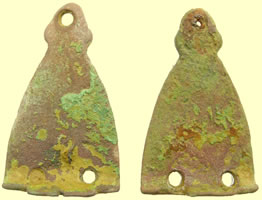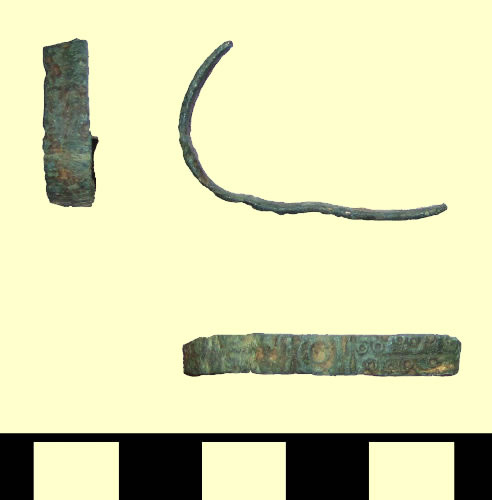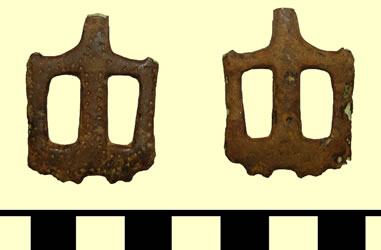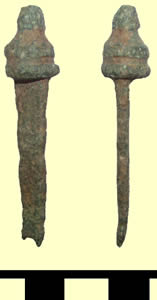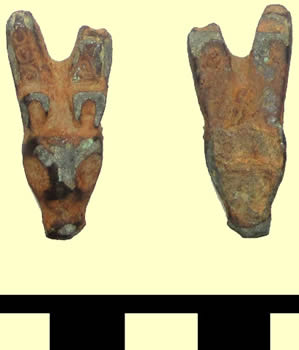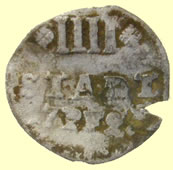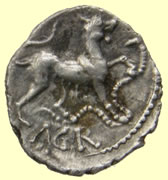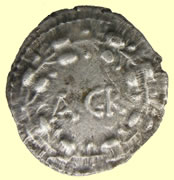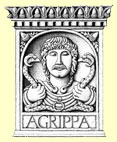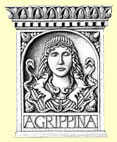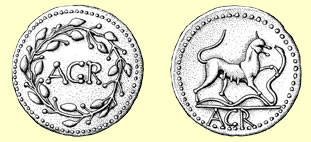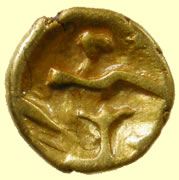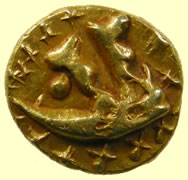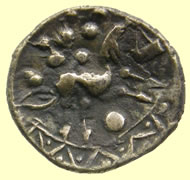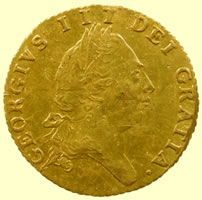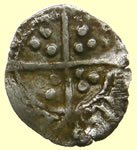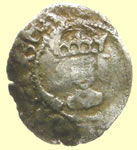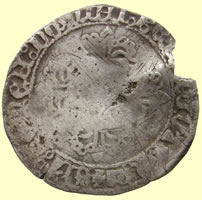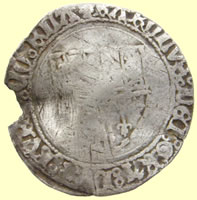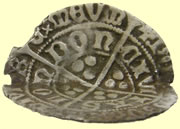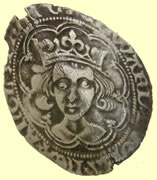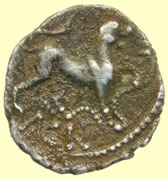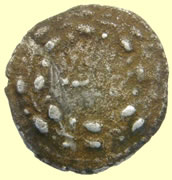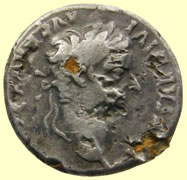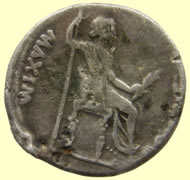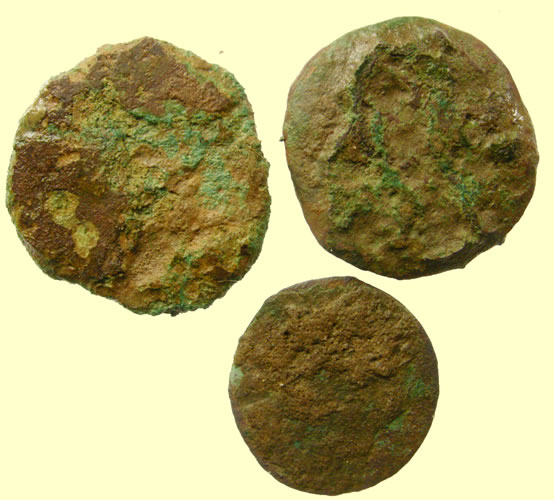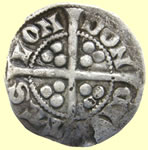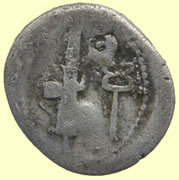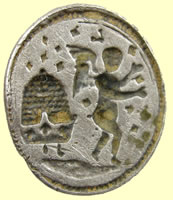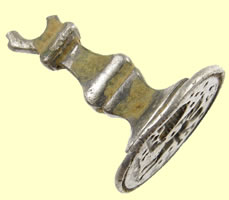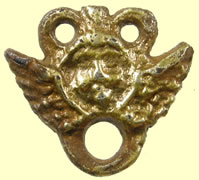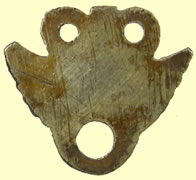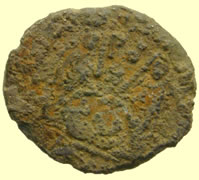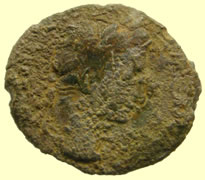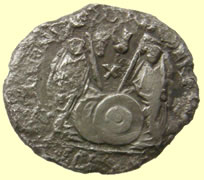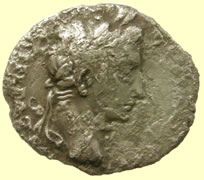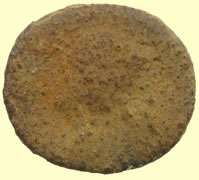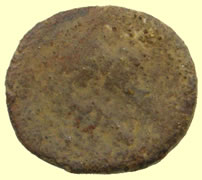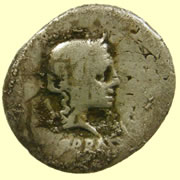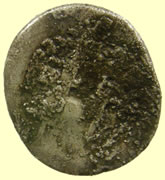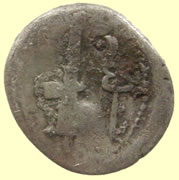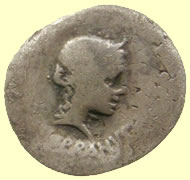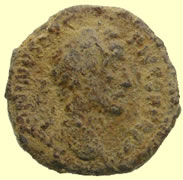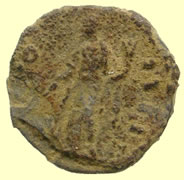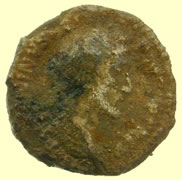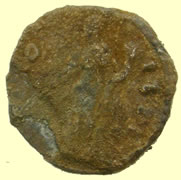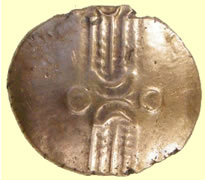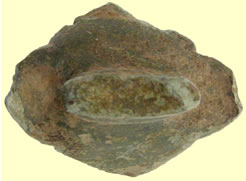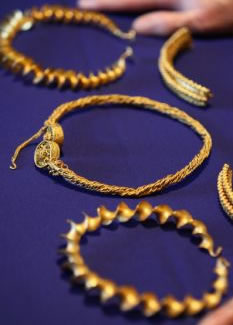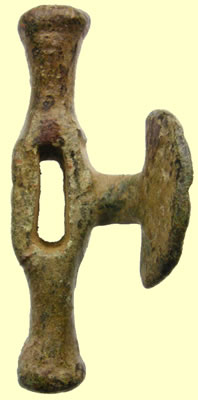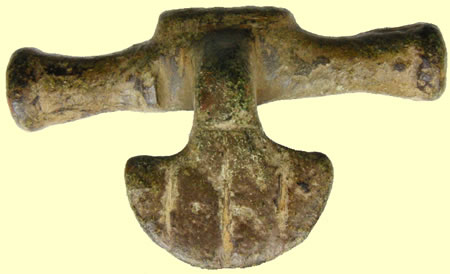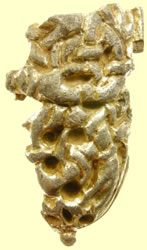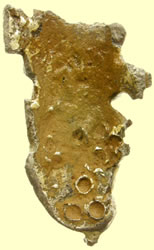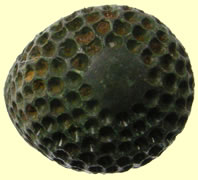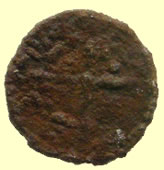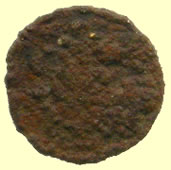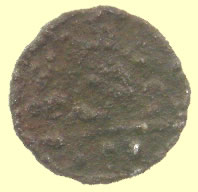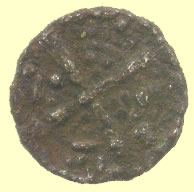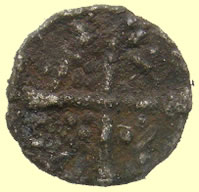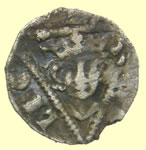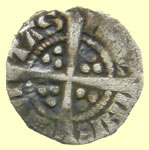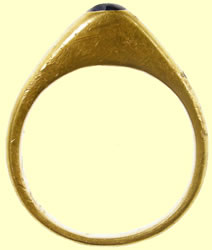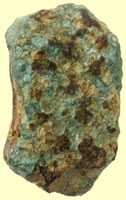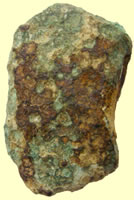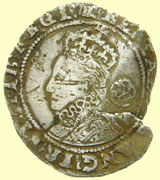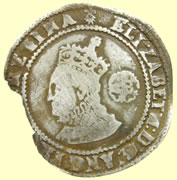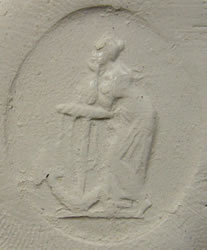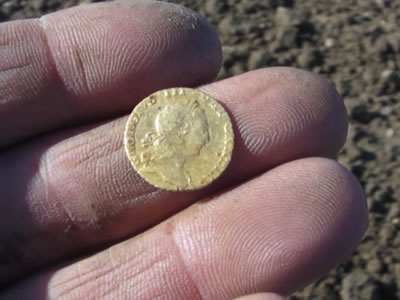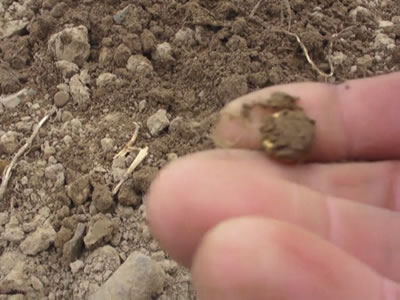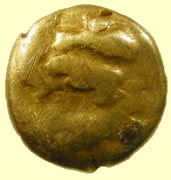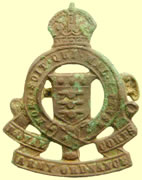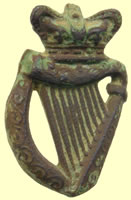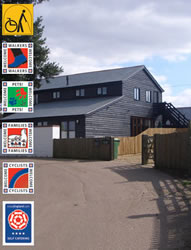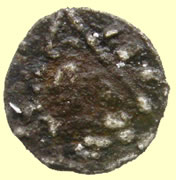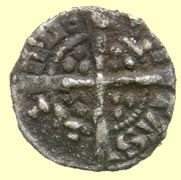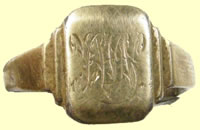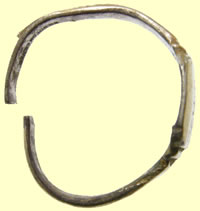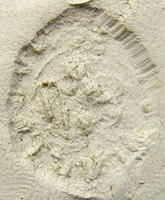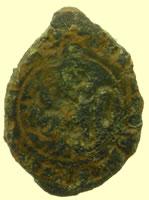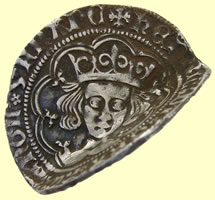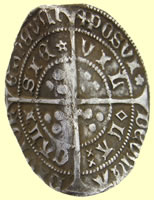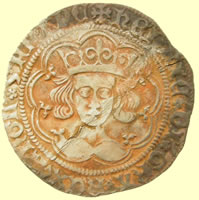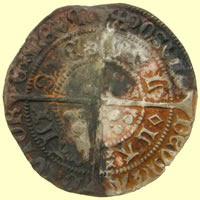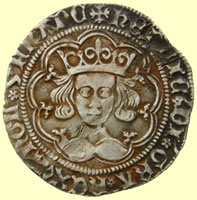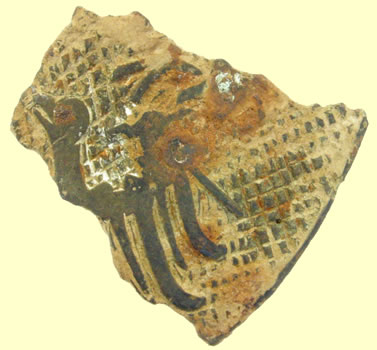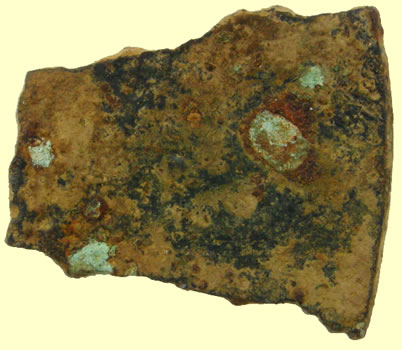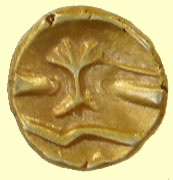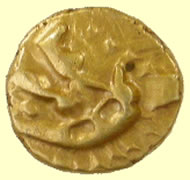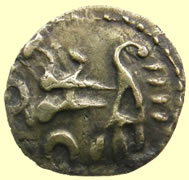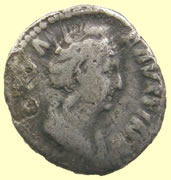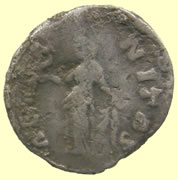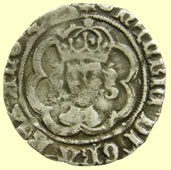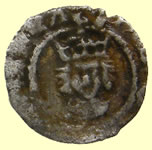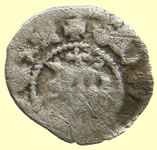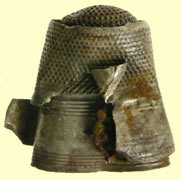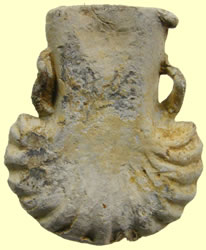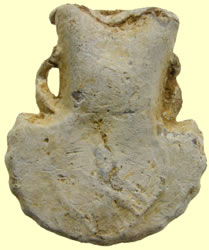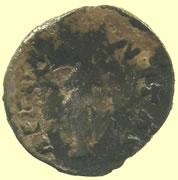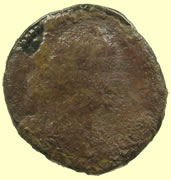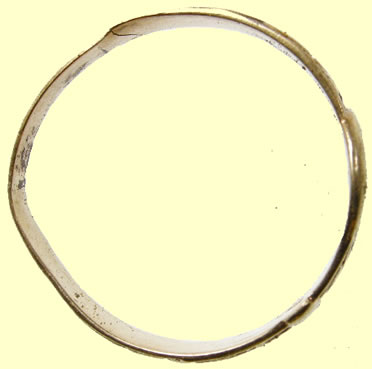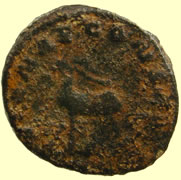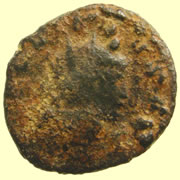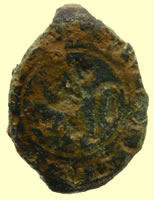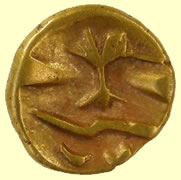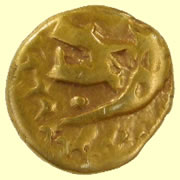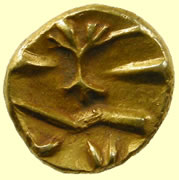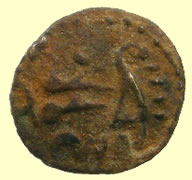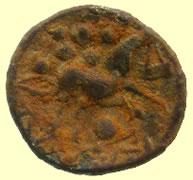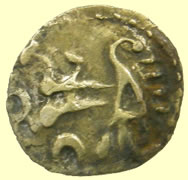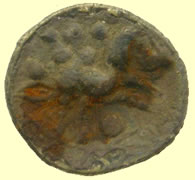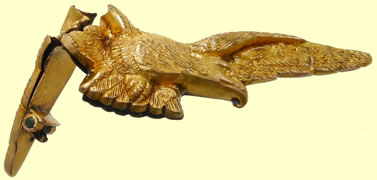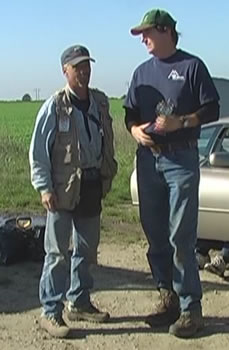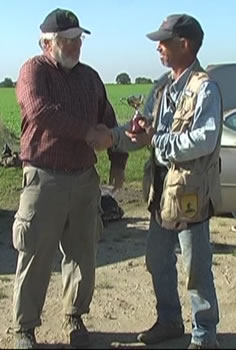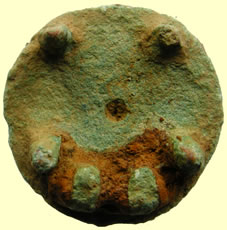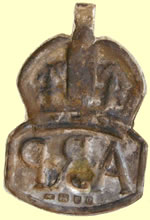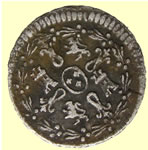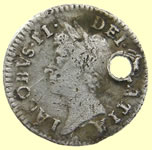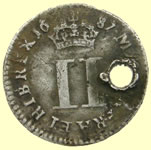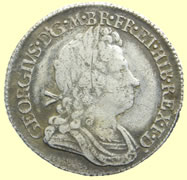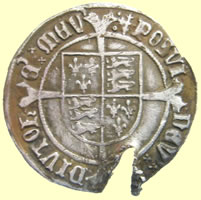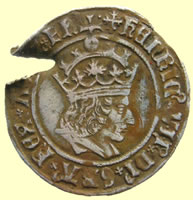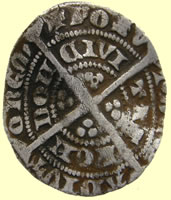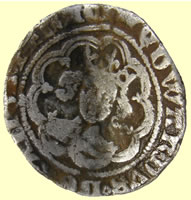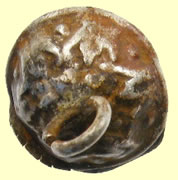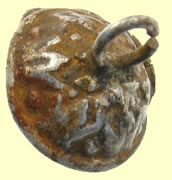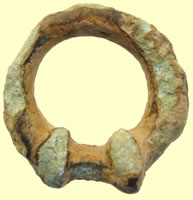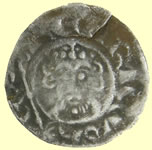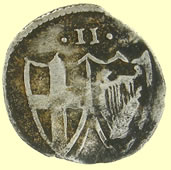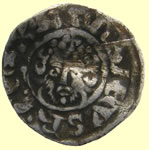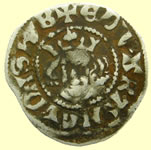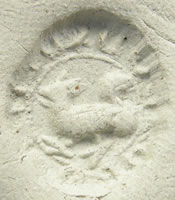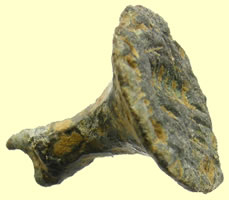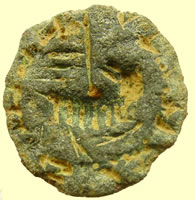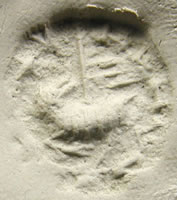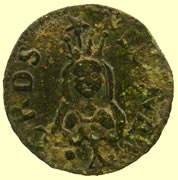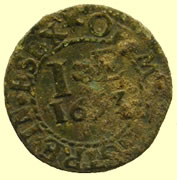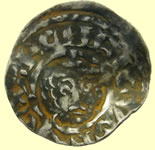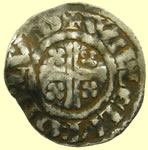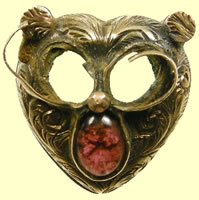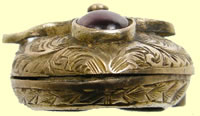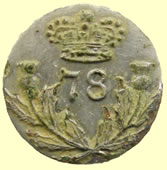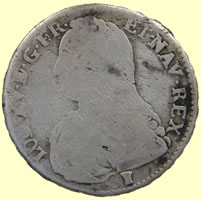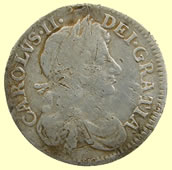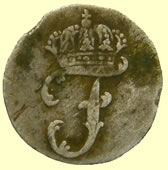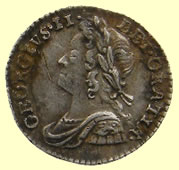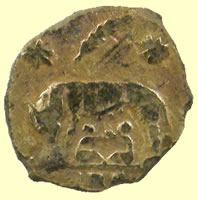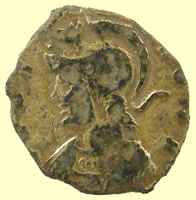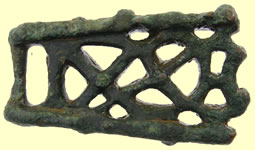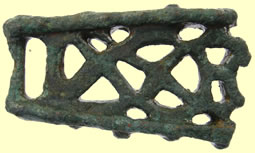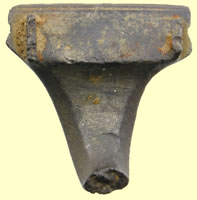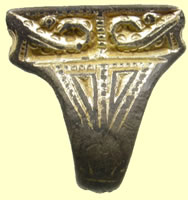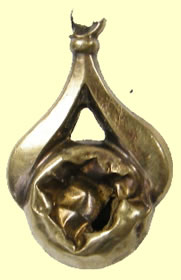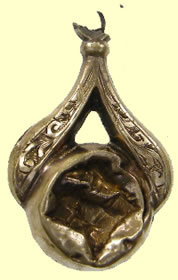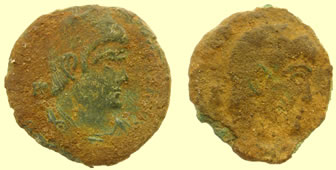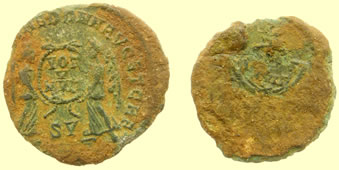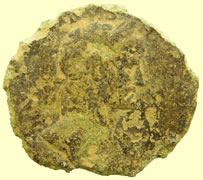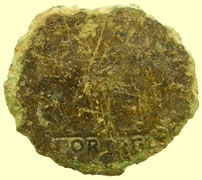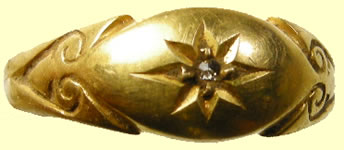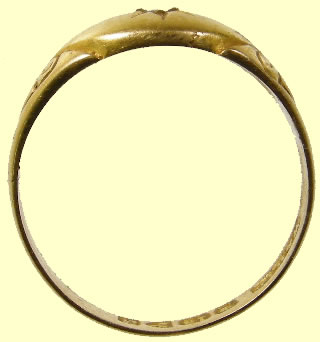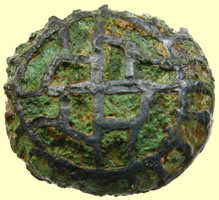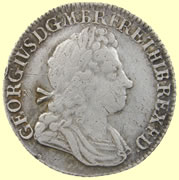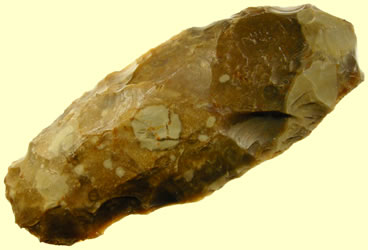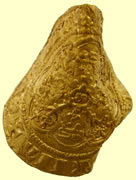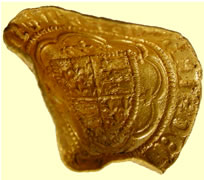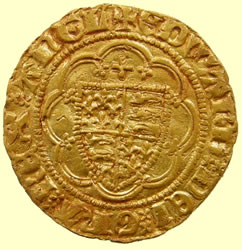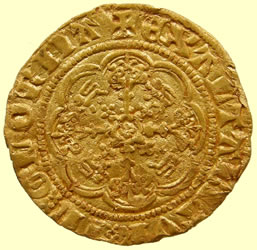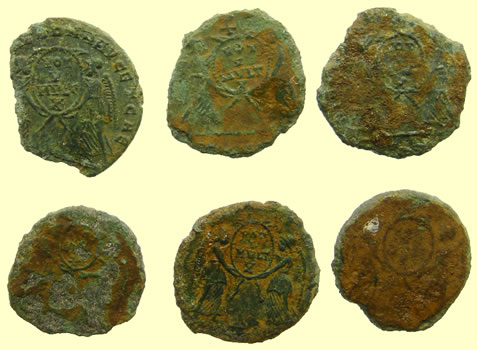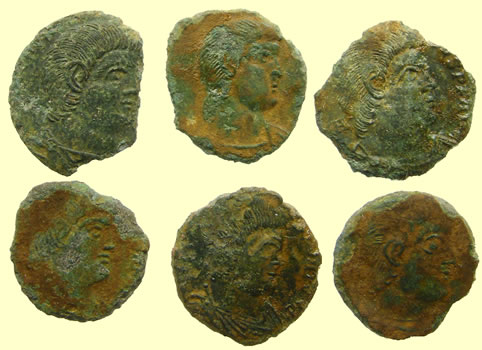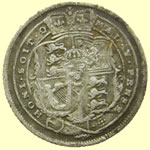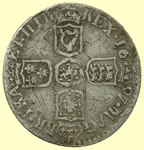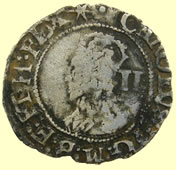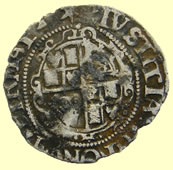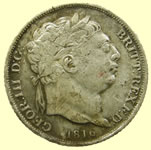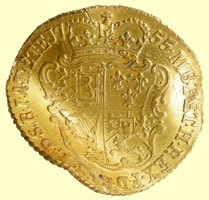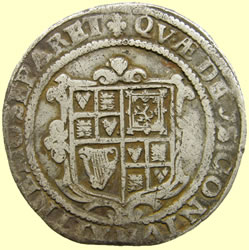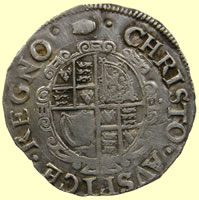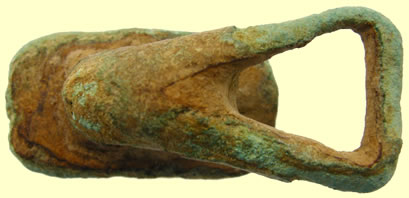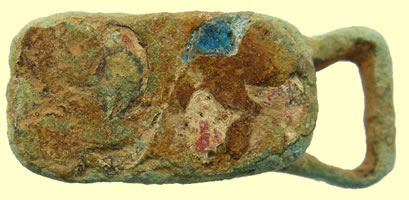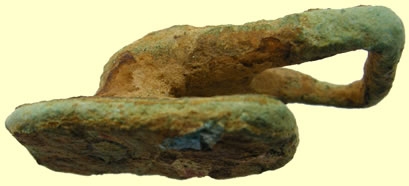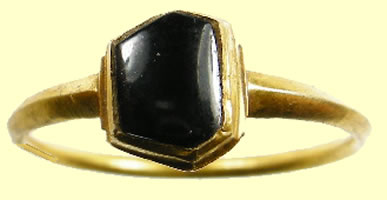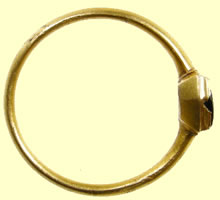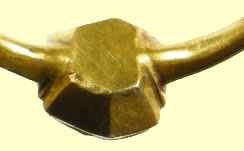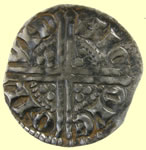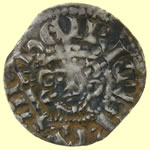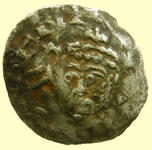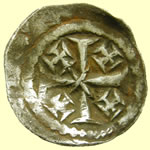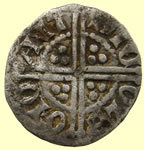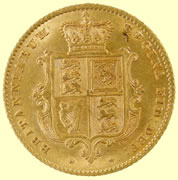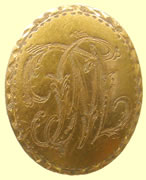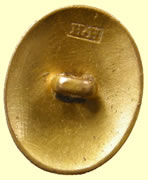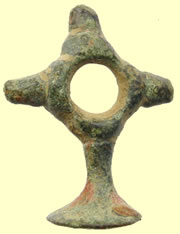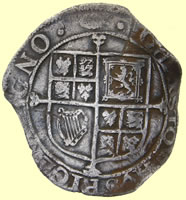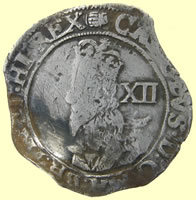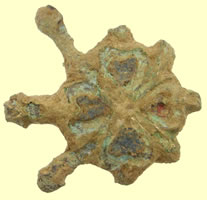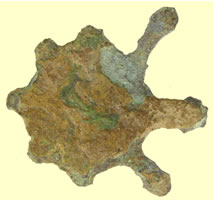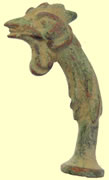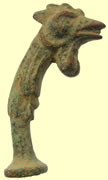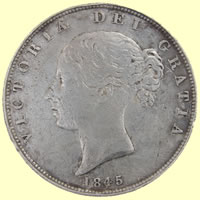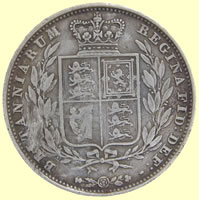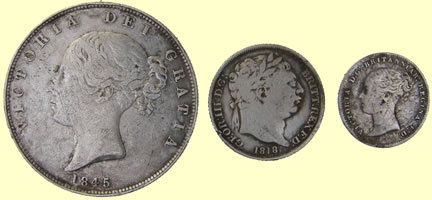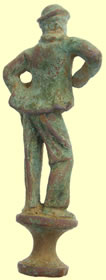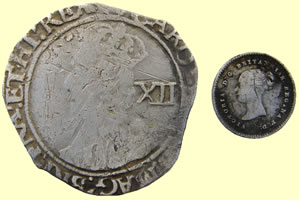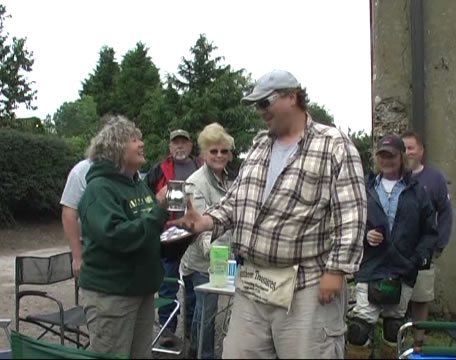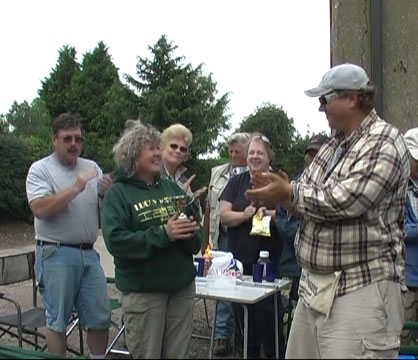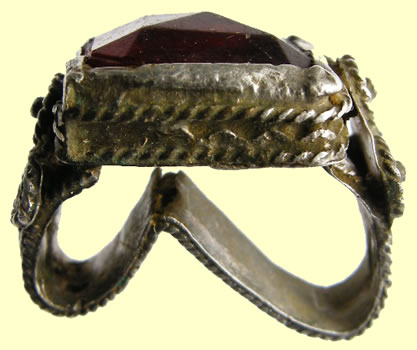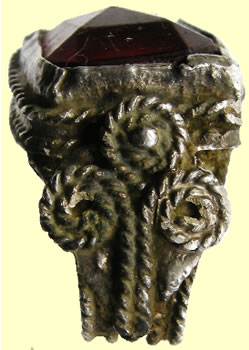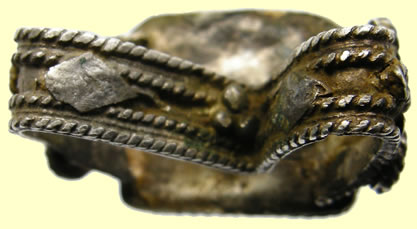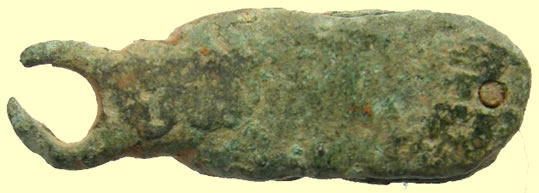

Metal detecting holidays in England with the World's most successful metal detecting club.
Twinned with Midwest Historical Research Society USA
2010 Sept to 2011 Jan Archived news page |
27th Jan 2011 £2000 for Gene's ring - Rare Conder token cleaned No sign of any approved export licenses yet or the return of all our Roman coin finds still with the British museum expert. Uploaded more finds lists and export pics to the members forum. Updated the free forum competition page with the latest count Ill Gene just received the valuation letter for his gold ring treasure below from last season and it is a very good result at £2000. The farmer and finder automatically get a 50/50 split by law.
Can Bill was cleaning up his old copper coins from his last exported pouch and discovered a really neat Conder token. I thought it could be a rare one as I could not find Britannia on any of the reverse of the Chichester issues. Can Bill did more research and found it is indeed a rarer example.
Sussex Chichester. Halfpenny 1794. Front face of Queen Elizabeth I with crown and sceptre. QUEEN ELIZABETH. Rev.: Chichester Cross. CHICHESTER HALFPENNY. Edge: PAYABLE AT DALLEYS CHICHESTER
1795 Sussex D&H 17b Chichester SCARCE
Found the Lizzy condor token and it is a rare sucker! Bill Conder Tokens are named after James Conder who was an early collector and cataloged these interesting coins. They are copper coins (usually pennies and half pennies) minted by towns, businesses, and organizations of all types to meet a need for low denomination coinage that was not being provided, not being minted in sufficient quantity by government, or not making it out to the small towns. These lower denominations were needed to pay workers and make change in an increasingly industrialized society. Thousands of varieties of tokens were minted, many are beautiful and intricate works of art. Because Conder Tokens were minted independently of government, the creators of these tokens had the freedom to make political statements, social commentary, honour great men, ideals, great events, or just advertise their businesses. Subjects range from Isaac Newton to Abolition and Prisons to Mental Institutions, issuers of the coins need only have the means and the will to mint their own coin. Most were officially payable only in certain areas and locations but there is no doubt that copper coin was copper coin to many at the time and they were widely circulated.
Ill Gene's gold ring treasure report
Treasure Report: 2009 T110 JPR/EM A Medieval finger-ring consisting of a single loop, flattened, with an inscription running along the narrow internal surface. Much of the inscription is illegible, but the remainder appears to read: TOUT ??E ?E VOUS CE ??UE The language is French and the disposition of the words characteristic of late medieval love tokens. The finger-ring is gold and dates from the fifteenth century. Dimensions: external 22 mm, internal 18 mm. Consequently, in terms of age and as the object contains a minimum of 10% precious metal it qualifies as Treasure under the stipulations of the Treasure Act 1996.
|
||||||||||||||||||||||||
22nd Jan 2011 More exports- database entries and donation letters
More nice bonus do dads out of the export bags
Ron just posted his latest detecting vid below.It features senior club members Chicago Ron, Joe and Mark practicing hard for their trip here in March, finding great silver out in the woods in Chicago. Ron's Barn team still has a couple of free spaces on one of the weeks (18th to 25th March) if you want to join them. Ron's boys are doing 5 weeks total so lots of serious hunting with the top experts in our club if you want to learn a few tricks of the trade and improve your game.
Chicago Ron's new video - USA finds Still busy just banging away at the paperwork before the start of the 2nd half of the season. The first batch of export license applications have been approved and should arrive shortly. They were delayed due to a couple of additional potential Roman bronze coin hoards on the applications that had already been disclaimed by the British museum in 2009 but they needed the Treasure Case numbers. All export license applications are scrutinised by an expert advisor at the BM to check that there is nothing contentious on the applications that require more information. More complete export and finds lists posted on the members forum. Colchester museum had finally sent out the thank you letters to finders and farmers who have donated some of their important finds this year. If you were waiting for your letter is should be with you shortly. If you register with PAS at http://finds.org.uk/database it is now possible to view all your finds that have been recorded by us on the National database under just your name so you have a complete list. Some more of our recordings and ID's this year posted below. Interesting to note the bronze Roman item that looked like an ornate spindle whorl is a Roman weight.
ESS-7E7CB5 Celtic MOUNTA cast copper alloy looped object in the shape of a stylised bird. This is possibly a vessel mount but it is hard to see how it would have been affixed to a vessel and there are no rivets nor signs of soldering. Late Iron Age or Roman in date. The bird is formed from a lozenge-shaped piece of copper alloy (the body and wings) with two terminals. One terminal is a circular disc and the other is a narrow projection, bent under at the end to form a beak. The lozenge is not flat but has been bent down the middle to form a ridge. There are incised double lines around the edge of the lozenge. On the underside of the bird is an integral loop at 90 degrees to the body. The loop is 14.75mm in external diameter. The hoop is 2.2mm thick and D-shaped in section. Length of object 33.81mm, width 14.52mm, height 14.21mm, weight 5.21g. The object has the appearance of a napkin ring but on a much reduced scale. Chronology Broad period: IRON AGE Dimensions and weightLength: 33.81 mm Materials and constructionPrimary material: Copper alloy Manufacture method: Cast Decoration style: Zoomorphic Completeness: Complete
ESS-7E1611 Roman WEIGHTCast copper alloy weight. It is biconical with a central circular perforation. A large amount of the original surface is missing, where it does survive, it is covered in vertial incised lines. It is 16.04mm thick, 23.36mm in diameter, the central perforation is 7.97mm in diameter. It weighs 27.30 grams. ChronologyBroad period: ROMAN Dimensions and weightThickness: 16.04 mm Materials and constructionPrimary material: Copper alloy Manufacture method: Cast Completeness: Complete
ESS-7F21E5 Medieval BROOCHMedieval cast copper alloy annular brooch circa AD 1200-1400. The brooch is formed of a circular ring with a short recessed bar where the copper alloy pin is attached. The frame is decorated with regularly spaced narrow grooves giving the surface the apearance of raised rectangles. The frame has a shallow rectangular cross section. The brooch and pin are red-brown in colour. The brooch has an external diameter of 15.98mm, and internal diameter of 10.58mm, is 1.69mm thick and weighs 1.3 grams. Class: Annular ChronologyBroad period: MEDIEVAL Dimensions and weightThickness: 1.69 mm Materials and constructionPrimary material: Copper alloy |
||||||||||||||||||||||||
16th Jan 2011 Two weeks to the kick off - more ID's and exports Still busy working my way through the export applications and have posted a load more find lists and pictures to the members forum. Just two weeks left before we kick off the second half of the season, I will just about get them all finished and the guys will start digging tons more for me to fondle !! I have posted a few more of our latest PAS Roman database entries including the huge bag of Roman and medieval pottery Mass Linda picked up on her travels across the fields.
ESS-E9CBE6 TILERoman roof tile: 6 fragments of tegula and 1 fragment of imbrex Roman pottery: 1 sherd of samian, 1 sherd of samian mortaria, 1 sherd of cream-coloured mortaria Possible Medieval or Post- Medieval pottery: 1 sherd of rim in orange fabric, 1 body sherd in reddish fabric with crushed stone temper Post-Medieval pottery: 2 rims and 2 handle fragments of Post-Medieval red earthenware with brown glaze Undated pottery: 3 sherds including one handle fragment Class: tile and pottery ChronologyBroad period: ROMAN
ESS-C07014 BROOCHA cast copper alloy early Roman bow brooch. This is a Dolphin or Polden Hill Brooch dating from the mid to late 1st century AD. The spring, pin and catchplate are missing. What survives are the bow and wings. The wings are 30.33mm wide and are hollowed on the intertior to receive the missing spring. The exterior of each wing is decorated by a vertical groove at each end and a diagonal groove. One long edge of each wing is decorated with a row of punch dots. The surface of the bow is damaged. Three longitudinal grooves have been incised along its length. The interior of the bow has a scar where the catchplate joined. At the head of the brooch is a rearward claw which would have held the spring chord. The brooch is 50.72mm long, the thickest part of the bow is 5.93mm. It weighs 13.01g. The surface is pitted and there is light green corrosion in the pits and on the damaged areas. The patina is dark green. Class: Two piece ChronologyBroad period: ROMAN Dimensions and weightLength: 50.72 mm Materials and constructionPrimary material: Copper alloy
ESS-C03D13 HARNESS FITTINGEarly Roman (40-100AD) cast copper alloy harness fitting. The terret is incomplete, formed of two loops one above the other (figure of eight). The larger loop is damaged and incomplete. There is a worn break around the smaller loop, possibly from a damaged 'skirt'. The surviving section of the main loop is 37.76mm long, 3.97mm thick and the smaller loop is 27.47mm long, 6.19mm wide, 4.91mm thick. It weighs 30.71 grams. Class: Terret ChronologyBroad period: ROMAN Dimensions and weightWeight: 30.71 g Materials and constructionPrimary material: Copper alloy
ESS-C026D6 BROOCHRoman cast copper alloy dolphin brooch with hinge mechanism. The wings are tubular with vertical mouldings along their length. There is a slot in the reverse of the wings for a missing hinged pin. The bow has a pronounced arch towards the head end. There are some vertical mouldings along the length of the bow. The bow tapers to a point and there is a line of scaring on the reverse of the bow where the catchplate would have been located. The brooch is 49.82mm long and weighs 13.51 grams. It is 32.15mm wide across the wings with a diameter of 5.76mm. The bow is 9.76mm wide towards the head end. It is 16.88mm deep. The surface of the brooch is pitted. Class: Dolphin Subsequent actionsSubsequent action after recording: Finder applying for an export licence ChronologyBroad period: ROMAN Dimensions and weightLength: 49.82 mm Materials and constructionPrimary material: Copper alloy
ESS-BFCFD3 LOCKRoman cast copper alloy lock-pin with bell-shaped head. The head is cylindrical with two raised collars around its circumference and a sub-circular knop at its apex. The shaft is rectangular in section and in plan, with a worn break across what apears to have been a circular opening. The lock-pin is 56.72mm long, the head is 12.81mm in diameter and the shaft is 8.46mm wide and 3.72mm thick. It weighs 12.9 grams. It is mid-green in colour and has a pitted surface. There is light green corrosion product within the pits. Another example on the database is NMS-B62B37. ChronologyBroad period: ROMAN Dimensions and weightLength: 56.72 mm Materials and constructionPrimary material: Copper alloy |
||||||||||||||||||||||||
11th Jan 2011 More exports and widgets - PAS recordings
John T sent me a couple of stunning coins for fixing - James 1st Scottish hammered gold and a Saxon silver penny - both currently with our gold smith Still working my way through the export pouches and post a load more with find lists and pictures onot the members forum. There have been some great bonus do dads in the pouches guys did not have time to show while the hunts were in full swing. LA Jim had one of the nicest looking 15thC animal headed vessel spouts I have seen found here in his pouch. I have also been working my way through the last box of relics returned and recorded by the museum on the PAS system. I have posted a few below with their PAS reference number. Note Orv's Iron age razor backed boar find has been designated County / local importance, massive find. Check out the National database for relics and coins at http://finds.org.uk/database. It is brilliant resource to ID finds and to view your own finds. Updated the free forum competition page with the latest count at 102 ancient coins so far out of the export pouches
Vessel spout Broad period: MEDIEVAL
ESS-BFC746 SEAL MATRIX (Certain)Medieval cast copper alloy seal matrix, circa AD 1200-1400. The die is circular in plan with a cylindrical faceted handle extending from the reverse. The handle has a wide, triple banded collar before a trefoil terminal comprised of three openwork circles. The motif on the die is rather crudely engraved. There is a ?shield surmounted by a sword on its side. The two are connected by a strange squiggle. Either side of the shield are the letters 'R' and the smaller 'H'. When impressed into a seal the letters would come out back to front. Diameter of die 22.1mm, height 30.35mm, weight 18.1g. The object has a mid green patina and the edges are a brown colour. Most of it is covered in a light green corrosion product. It looks like someone has engraved the die but forgotten to write the letters backwards. ChronologyBroad period: MEDIEVAL Date from: Circa AD 1200 Dimensions and weightHeight: 30.35 mm
ESS-BFB3A0 SEAL MATRIXMedieval cast copper alloy seal matrix. The matrix is circular with an openwork quatrefoil handle on the reverse. There is a small suspension loop at the top of the handle. The seal impression is of a left facing bird with an open wing behind. There is no legend. It is 13.23mm in diameter, 27.77mm long. The handle is 15.71mm wide, 2.64mm thick. It weighs 4.35 grams. Subsequent actionsSubsequent action after recording: Finder applying for an export licence ChronologyBroad period: MEDIEVAL Date from: Circa AD 1300 Dimensions and weightLength: 27.77 mm
ESS-BFB006 SEAL MATRIXMedieval cast copper alloy seal matrix. The matrix is circular with a six sided faceted handle on the reverse, terminating in a suspension loop. From the impression, the design is of a right facing owl with star above, surrounded by the legend *hELE CVR SAYLOVLE. It is 16.30mm in diameter, 19.80mm long and weighs 5.35 grams. ChronologyBroad period: MEDIEVAL Date from: Circa AD 1250 Dimensions and weightLength: 19.8 mm
ESS-C5CB81 FIGURINELate Iron Age or Early Roman cast copper alloy figurine in the form of a standing boar. It is a fairly realistic rendering of a razor-backed boar. The figurine is of solid copper alloy has a pointed snout, oval eyes with blue and red enamelling and a ridge along its back representing dorsal bristles. One ear is missing and the other one is represented by a small curved ridge . Scarring around the snout may indicate two broken off tusks. Scarring at the rear may indicate a broken off tail. One of the hind legs has been bent slightly inwards and no longer touches the ground. Length 66.45mm, width 20.56mm, height 40.02mm, weight 110.4g. The surface has some damage and there is wear to the snout, legs and ridge. Otherwise it is in good condition. The surface is smooth, with a mid green patina and light green corrosion product on the damaged and worn areas. Another boar figurine has been recorded on the database - LIN-2CFD83. Notes: Seen by Sally Worrell This is a find of note and has been designated: County / local importance Subsequent actionsSubsequent action after recording: Finder applying for an export licence ChronologyBroad period: IRON AGE Dimensions and weightLength: 66.45 mm Materials and constructionPrimary material: Copper alloy
|
||||||||||||||||||||||||
8th Jan 2011 Ron's new detecting vid - more updates Chicago Ron has put together some of the highlights of his teams latest Oct trip here in his new video. Amazing to see the guys digging Celtic and milled gold coins fresh out of the ground. Ron still has a couple of slots free on his March trip if anyone wants to join our most successful 'Barn' team. Check out all the other members video on the Video page Contact Ron via ChicagoRon.com for more info or drop him a mail rpg61@msn.com
Updated a few of our smallest individual find pages with the latest finds from the first half of the season. All the sites individual find pages can be viewed via the Finds index menu. There are over 200 pages to view !!!
|
||||||||||||||||||||||||
6th Jan 2010 Loads more exports and treasures
Hope you all had a great new year celebration and looking forward to the start of the 2nd half of the season which is on the 9th Feb. Just a month to go before Mindy's first 'Barn bandits' arrive for the kick off. Mindy is running 3 separate self catering Barn weeks here in the 2nd half of the season and there is still one free slot on her April weeks hunt. I have invested in a new state of the art Sat Nav system for the self catering 'Barn' teams to use so that it acquires the satellites quicker and has blue tooth. When you are on one of our 'go as you please tours' with your own minibus every site is programmed in so you don't get lost out there. There are over 300 fields available for detecting which you choose from each day so a quick responsive Sat Nav system is a must. You also get full set of AO sizes maps of each site + individual A4 maps to carry. There are still the odd free slot on a few the Barn teams if you fancy joining the club. Louisiana Sal's 26th Feb to 5th March Mindy's Barn 18th to 25th April During the holidays I have been busy loading a load more export find pouch photo's and lists to the members forum and updated the free forum competition page with ancient coin total so far. I checked yesterday with the British museum and all our Roman coin finds being recorded and evaluated by their expert are still a month away from being returned. The local FLO has to physically take a trip to London to pick them up. I also received letters from the British museum and 3 of the 17thC Charles II silver button/cufflink finds have been disclaimed and being returned to the finders. Treasure Act 1996: 2010 T260, Post medieval silver cufflink from the Colchester area of Essex. Treasure Act 1996: 2010 T259, Post medieval silver cufflink from the Colchester area of Essex Treasure Act 1996: 2010 T261, Post Medieval silver cufflink from the Colchester area of Essex. There were a couple of really nice lead finds I cleaned up out of the export pouches and the token is the first one I have ever seen dated. It is very similar in design to those 17thC hammered copper trade farthings used widely in this area.
1678 dated lead token
Lead trade weight Georgian - Circular Libra mark of the Worshipful Company of Plumbers. |
||||||||||||||||||||||||
28th Dec 2010 More updates Updated more individual find pages with this seasons finds so far. On the Georgian page it is interesting to note how rare George 1st & 2nd coins are to find, to get 3 this half season, including a gold guinea, is very rare for us. The bulk of the Georgian finds are during the George III period. If you look at the William III page these 17thC silver coins were still being used right up to the late 18thC hence there a a large number of the heavily worn examples. In 1699 Sir Isaac Newton was appointed Master of the Mint. He took a great interest in it's operations and did much to improve it's operation. After his death in 1727, the mint seems to have been almost forgotten. The output of silver and copper coinage dwindled as the 1700s progressed and by the 1790s there was a dangerous shortage. The gap was filled with a token coinage issued by merchants. In 1797 Matthew Boulton was awarded a contract to issue copper coinage on steam powered presses designed by James Watt. At the same time Spanish coins were counterstamped or overstruck and passed at 4s. 9d. and 5s. respectively. In the early 1800s it was decided that the mint had outgrown it's medieval location in the Tower and it was moved to a new building on Tower Hill and outfitted with Boulton's steam presses.
|
||||||||||||||||||||||||
27th Dec 2010 Happy Christmas all - Whistle museum - more updates Hope all the members and users of this site had a great Christmas and looking forward to a happy new year. I have far too much to do before the hunts start again in Feb so I will not be taking much of a break. I have uploaded more export find sheets and pictures to the members forum and updated the following individual find pages with the finds from the first half of the season. I have finished uploading all this season gold coin finds to our online database at Foundintheground.com so I can now see the accurate running totals. We have found 86 Celtic gold coins and 48 ' modern' milled gold coins. Total hammered gold, includes Roman, Celtic Saxon and Medieval etc = 115 http://foundintheground.com/photos/ So you are twice as likely to find Celtic gold than modern gold and nearly 3 times more likely to find hammy gold then milled, interesting. I found an interesting link to our site from a Whistle museum that was using a picture of Chicago Ron's find which turns out to be a rare medieval hawking whistle http://whistlemuseum.com/2009/08/13/...l-period-.aspx Dr Philip de Jersey has kindly recorded and sent back the CCI number for Louisiana MIke's Celtic gold find below and confirmed my ID as a Waddon Chase type. This is CCI 10.2870 and will come under ABC2433 in Chris Rudd's new Catalogue Phillip
1stC BC Uninscribed 'L' 'Waddon Chase type' Celtic gold full stater - sent to CCI for recording 5,86g, 1.6mm 'These coins are probably not very much earlier than the Addedomaros staters - it all depends really on when one dates the Addedomaros issue. It seems fairly certain that the Whaddon Chase staters could be from the later stages of the Gallic War, say about 54 BC at the earliest; they could be a little bit later, but are unlikely to be after say 40 BC at the very latest.' Dr Philip de Jersey Updated the free forum competition page with the latest count
Decorated hawking whistle found by Chicago Ron- rare medieval example featured on the whistle museum web site Interesting link to one of our finds featured in a whistle museum web site, rare find
|
||||||||||||||||||||||||
23rd Dec 2010 More exports and club raffle results
Still busy working my way through the export preparation documents and uploaded more find list and pictures to the members forum. Penn Dennis's pouch is certainly in the running for this years 'Pouch of the Year' award. Beauty Celtic gold, 83 BC Roman silver and his amazing dagger quillion that I will be dropping off to the museum shortly for evaluation and recording.
Page 1 of 6 - posted in full on the members forum 1. Georgian navy seal on red stone
I have updated my personal fav's this season so far to the Find of the Year page . At the end of the season every guy that comes here gets to vote for his personal favourite find throughout the season (not his own finds of course) The find with the most votes gets the holder a free weeks full board detecting next season and the engraved Roman jug, not forgetting his name on the role of honor shield ! These are not the definitive list but are a few of my current favourites, guys can vote for any finds that are on our site for the season 2010/2011. Updated the free forum competition page with the latest count
Chicago Ron video'd the raffle draw at his metal detecting club to win another free weeks trip here. Results and video link below.
|
||||||||||||||||||||||||
18th Dec 2010 More exports and updates Louisiana Mike has sent me a great day by day write up on his trip in Nov and I have posted it to the testimonial page Uploaded more export find sheets and pictures to the members forum. Updated loads of the individual find pages below with this seasons finds so far. Updated the free forum competition page with the latest count Washington Tom has been doing more research on his Arabic looking seal matrix find from Oct and a friend translated it for him, very interesting
17thC seal matrix Basically the seal has two Arabic words “khulqahu – subhanahu” which are attributes of God meaning something like “Allah, to whom be ascribed all perfection and majesty, as confirmed through His creation”
If I had to translate it using fewer words, I would say “Glory – His Creation”
|
||||||||||||||||||||||||
16th Dec 2010 More exports and Saxon ID's Still busy preparing the export documentation and posting more full finds lists with photo's onto the members forum. Updated the free forum competition page with the latest count Great ID back from Dr Martin Allen at the early medieval corpus database on the Saxon silver penny just fixed and his views on Cal Jim's very interesting research.
12.44mm, 1.02g Cal Jim has been doing some serious research on a Saxon looking coin found by Chicago Ron in Oct. I had previously sent it to Dr Martin thinking it too looked Saxon but Martins reply suggested it looked Asian so I posted it on several Asian coin forums with no success. However Jim research shows it has a lot of Saxon similarities so I resent it back to Martin.
Understanding that the experts know a lot more than I do, and with all due respect, I still think this coin is Saxon. I think the closest match I have seen so far is this coin here: (pictured directly above)
I resent Jim's views and pictures off to Dr Martin and his reply did not rule it out as being a new Saxon type. Very interesting. I shall archive the images of this coin in case any more convincing evidence or Anglo-Saxon origin should emerge. With thanks. Martin
Minimal straightening sent in by Bury John 'Thank you for this interesting coin, which I have recorded as EMC 2010.0422. This is a William II type 2 penny of the Ipswich moneyer Ælfwine, providing a new type for a moneyer previously only in the Paxs type (William I type 8). The reverse reads +IELF[ ]INE ON GIP.' Best regards, Martin
|
||||||||||||||||||||||||
10th Dec 2010 Saxon coin ID's - Pouch of the year video
Louisiana Sal's sent me hundred of clips he took with his hat vid cam on the last hunt before the 1/2 season break. He captured all of Mike's 'pouch of the year' finds as he dug them so I have knocked together a quick vid primarily showing Mike in action. There is a bit of swearing when Mike found his Celtic gold as he was well pumped. Sal is running another 'hard core' hunt in Feb if you want to join his team but be warned these are 14 hour days on 300 + fields. Sal drives his own mini bus so you come and go as you please and hunt to your arm drops off. Drop Sal a mail sal@historyhunts.com for more info. http://www.colchestertreasurehunting.../mikes2010.wmv I have uploaded more export pictures and find lists onto the members forum
Saxon silver penny - Æthelred II 978 AD of the 'Benediction Hand' type 20.85mm dia - 3g - Recorded as EMC 2010.0305
Now Oregon Clarence's Saxon silver penny is fixed Dr Martin has sent back the revised ID. Congratulations on the successful unbending of this coin. I can now see that it is a coin of the Canterbury moneyer Lifinc from the same dies as coins in Copenhagen (SCBI 7, 90) and Poznan (SCBI 37, 11) reading With thanks, Martin
Found by Lincs Robert and sent to me to fix it Æthelred II Long Cross type. Martin |
||||||||||||||||||||||||
7th Dec 2010 Coins fixed and more exports
Chicago Ron's first page of his 12 find sheets - monster pouch
Posted a load more export sheets on the members forum and found lots of nice bonus bits in the pouches including a real nice Roman bronze I soaked in distilled water and has excellent detail . I sent it off to Mark Lehman and he has ID'd it for us below. These 'holed' Roman coins were later used by the Saxons for pendants. I picked up the latest batch of fixed hammered coins and there are again some stunning results posted below. I am making up another batch of bent coins from the export pouches to take in for fixing shortly. Note with most ancient silver coins they MUST be annealed first in most cases to prevent them breaking. This is a tricky process and should only be undertaken by a profession like our goldsmith. Annealing precautionsWhen sterling silver is annealed, care must be taken to avoid "overheating"-a condition that increases hardness by promoting undesirable grain growth and a significant loss of ductility. In torch annealing, it is particularly important not only to see that no part of the work is overheated, but also that all parts of the object or article are brought to the full annealing temperature. Since sterling silver anneals so rapidly, it is not necessary to hold it at the annealing temperature for very long. Obviously, the use of a closed furnace has certain advantages, since the temperature of the object can be more precisely controlled-and the heat can be absorbed more uniformly. However, the annealing time must be established by trial and error for articles of different size and shape -and for different size furnaces. Controlling color and finish of silverIt is always preferable to anneal silver- alloys in a neutral or reducing atmosphere, in order to prevent the formation of copper oxides. In addition to using a controlled atmosphere for annealing, the alloy can also be protected from the air by coating it with Handy & Harman's Handy Flux. Any residues can easily be removed by rinsing the article in hot water, after it has cooled below a "cherry red" color. When silver alloys are annealed in open air, copper oxides will form. These oxides are of two types. The upper layer is cupric oxide, which has a black color; beneath the layer of cupric oxide there may also be another layer of oxide (cuprous oxide), which, because of its reddish color, is called "fire" The black surface layer of cupric oxide can be removed by dipping the article in a "pickling solution"- a 5%-10% water solution of sulphuric acid. The pickling action can be accelerated by heating the solution. After pickling, if a reddish layer is visible, it may be removed by polishing, but if it does not polish out, it can usually be removed by dipping the area in a cold, 50% solution of nitric acid. Since the nitric acid bath removes silver very rapidly, the operator must remove the article from the bath as soon as the fire is dissolved and rinse immediately with water. Any cloudy residue should be polished off immediately. The best annealing temperature for normal softening of sterling silver is between 1100ºF and 1200ºF (593ºC.-649ºC). Temperatures above 1200ºF (649ºC.) tend to dissolve the copper-rich phase, and, unless the cooling rate is rigidly controlled, maximum softness will not be achieved. At temperatures above 1300ºF (704ºC.) the article, if worked, will develop an "orange peel" surface. At temperatures below 1100ºF (593ºC.), the time required to achieve the desired results increases to a point where it becomes uneconomical. By applying Handy Flux paste to a section of the article prior to heating, the operator has an excellent visual aid for determining when the article reaches the proper annealing temperature, since Handy Flux becomes completely clear, like water, at 1100ºF (593ºC.). After annealing, the article may be either air-cooled or quenched in water.
Updated the free forum competition page with the latest count
This is a good bit later than any other roman you've shown me (that I recall). This is Valens (364-378 AD.) and the reverse type, SECVRITAS REIPVBLICAE with Victory advancing left holding a wreath and palm was part of a huge emission of basically 2 types (this one, and a GLORIA ROMANORVM with the emperor dragging a captive and holding a labarum) which were minted together from 364-378 for Valens, his brother Valentinian I, and nephews Valentinian II and Gratian.
Issued in such astronomical quantities from a few mints (like Siscia) that RIC and LRBC list pages of columns of field mark and exergual mint mark combinations for these two types, this one seems only to have an exergual mark - Heraclea, I believe - and in the absence of field markings, probably belongs to the first period, 364-367.
Mark
As dug, annealed and cleaned Saxon penny
Minimal straightening
As dug, annealed and cleaned Saxon penny Saxon silver penny - Æthelred II 978 AD of the 'Benediction Hand' type 20.85mm dia - 3g Now the coin is fixed I have sent it back to Dr Martin Allen at the early medieval corpus at the Fitzwilliam museum who needed to be able to see the reverse face for a complete ID I have provisionally recorded this as EMC 2010.0305, but it would be really helpful to see images after it has been straightened. These new images are really helpful, but the crucial part of the reverse inscription is the mint name, which is concealed by the bend
Ryan's fixed Edward III gold from Oct - stunning job
|
||||||||||||||||||||||||
3rd Dec 2010 More exports and updates Posted more find export sheets and photo's to the members forum and updated the free forum competition page with the latest count Updated the following individual find pages with this seasons finds so far. Amazing number of unrecorded military numbered regiment buttons found. We have almost of full set of every regiment now. |
||||||||||||||||||||||||
1st Dec 2010 Recorded finds and a shock Saxon treasure ID'd
Ancient gold ring bezel ? -cloisonné enamel-work 1.25g, 9.84mm dia Treasure Case No: 2010 T169. Gold cloisonné fitting from Colchester area , Essex I was checking on the progress of all our outstanding treasure cases with the treasure registrar at the British museum yesterday. A whole bunch are still awaiting the return of the specialist curators reports before they can go forward to coroners inquest. I have posted the curators report for Mitch Chris's gold ring find below . I had a real shock on the cloisonné enamel-work piece found above in March that it has been ID'd as Saxon making it a very special item. Ill Mark the finder wants to donate it to the museum so I will have to check with the landowner and see if he agrees. Both Mark and the landowner have already donated the Saxon strap end below he found on the same trip. I have picked up the last batch of our recorded relic type finds from the museum. All the Roman coins are still with Sam Moorehead at the British museum and I do not have a date yet for their return. I have updated the free forum competition page - total so far is 17
Anglo-Saxon strap ends date from 740-1100AD, peaking in the 9th century. It is likely that this example is of 9th century date.
Celtic gold qtr stater Cunobelin biga type 10 to 40 AD 1.36g, 10.93mm CCI 10.1014 I have posted another load of export pictures and full find lists on the members forum. Vegas Mike also had one hell of a hunt this season and his first gold coin in 20 years of detecting, almost another 'finds pouch of the year'. His Cunobelin Celtic coin is simply stunning.
Treasure Case: 2010 T165Colchester District: Post Medieval Finger RingPAS reference: ESS-8DC2D6
Date: Post Medieval - 16th to 17th Century Finder: Mr Chris Penning Date of Discovery: 7th March 2010 Circumstances of discovery: Whilst searching with a metal detector. Description: Cast gold finger ring with a groove around its circumference to give the impression of two bands. Each of the ‘bands’ is decorated with eight cast spirals, with each spiral separated by oblique lines. The recesses of the spirals contain traces of black enamel while the recesses of the oblique lines contain traces of white enamel. The inside of the hoop is inscribed over two lines: LET TRVTHE ADVANCE / ECHE FORTVNES CHAVNG (the last word was probably intended to be CHANCE). The ring is complete, but distorted. In its current condition it measures 25.93mm by 6.82mm. The band is 8.09mm wide and 1.97mm thick. It weighs 5.78 grams. Disposition: Colchester & Ipswich Museum Service have expressed an interest in acquiring this artefact. The object contains a minimum of 10% precious metal and is over 300 years old. Consequently it qualifies as Treasure under the stipulations of the Treasure Act 1996 in terms of both age and precious metal content.
|
||||||||||||||||||||||||
28th Nov 2010 Started the export pouches - pouch of the year ? I still had to photo some of the hammered silver finds and relics from last week out of Louisiana Mike's pouch and decided to make this last pouch of the season the first export application I make as it has to be one of the best 'pouches of the year' so far. Mike has 6 pages of finds and 110 buttons alone so did he ever sleep ? Remember every man made object over 50 years old must have an approved export license before it can be taken home. Each find has to be photo 'd, numbered and listed before attaching it to an export licence application. Export duty generally turn these around with 28 days once an expert advisor has checked the content does not include National important finds that should remain in England. I have posted the 6 other full pouch photo's and find lists on the members forum. I have started to update the free forum competition page to win a a free trip next season. This years comp was the guess the number of ancient coins found here. Mike got 4 Roman bronzes, Celtic gold and silver and a Roman silver so it starts the total off at 6.
1. 138-161AD Dupondius of Faustina II, wife of Marcus Aurelius bronze coin
Interesting obsevation below from Can Rob which he posted the members forum on Orv's Roman razor backed pig, currently with Colchester museum being recorded.
Orv's amazing piggy and the 20th Legion.....Curious thoughts....
|
||||||||||||||||||||||||
27th Nov 2010 Recorded finds on PAS - Paleaolithic flint hand axe
I have a meeting next week with the museum to pick up all our last recorded finds and they are now available to view on the PAS database. It is great to see some of our ID's confirmed like the two Roman bracelet finds and all the dozens of Saxon pieces. I have posted a whole bunch more of the ID's with write ups on the new Saxon harness and strap fittings page. It is interesting to note the find ID's as a Saxon girdle hanger. I had an e-mail in from the BM's Roman expert who has just about finished ID'ing all the Roman coins including our disclaimed hoards. Sam noted that some of the coins have been ID'd as scare so it will be interesting when we get them back. Check out the PAS database at finds.org to view all your ancient and medieval recorded finds 'I have done a large number of the coins already. Excellent to see them and vital they go on the Dbase. Although in generally poor condition, I have found some quite scarce and interesting pieces which I am sure will please the finders'. Sam
ESS-9E4FB2 STRAP END
2010 T167 Early Medieval strap end Date of Discovery: 12th March 2010 Circumstances of discovery: Whilst searching with a metal detector. Description: Early-Medieval Thomas Class A Type 1 strap end, cast in high tin copper alloy. The strap end is sub-rectangular in plan and rectangular in profile, increasing in thickness towards the terminal. There are two circular rivet holes at the split end; the copper alloy rivets survive but have become detached. The upper surface is decorated with a stylized foliate design, similar to the 'speckled fruiting plant' seen in Thomas (2003) figure 1.3. The terminal depicts a stylised animal head, with two large sub-rectangular 'ears' still visible, the remainder of the head is worn, however there are two slightly raised areas to either side that would have represented the eyes. The reverse of the strap end is plain undecorated. It is 36.18mm long, measures 10.66mm across the widest point, has a maximum thickness of 2.71mm and weighs 2.52 grams. Date: Anglo-Saxon strap ends date from 740-1100AD, peaking in the 9th century. It is likely that this example is of 9th century date. Disposition: Not Treasure. The finder reported this as treasure believing it to be silver. However, the strap end does not contain a minimum of 10% precious metal and therefore falls outside the stipulations of the Treasure Act 1996. Laura McLean Finds Liaison Officer, Essex Colchester & Ipswich Museum Service April 2010 References: Thomas, G. (2003) Late Anglo-Saxon and Viking-age strap-ends 750-1100. Parts 1 and 2. Finds Research Group 700-1700 Class: Thomas Class A Type 1 Subsequent actionsSubsequent action after recording: Returned to finder after being declared not Treasure Treasure detailsTreasure case tracking number: 2010 T167 ChronologyBroad period: EARLY MEDIEVAL Dimensions and weightLength: 36.18 mm Materials and constructionPrimary material: Copper alloy
ESS-BFE182 HANDAXE (Certain)
Incomplete Paleaolithic flint handaxe, circa 500,000 to 8,300 BC. Cordate in plan with bifacial working. The distal end is missing. Orange patina indicating depositon in river terrace gravels. Length 93.15mm, width 79.01mm, thickness 26.89mm, weight 110.5g. Subsequent actionsSubsequent action after recording: Finder applying for an export licence ChronologyBroad period: PALAEOLITHIC Dimensions and weightLength: 93.15 mm Materials and constructionPrimary material: Flint
ESS-C06995 Roman BRACELET
Roman (circa AD 250-410) cast copper alloy strip bracelet fragment with a worn break at both ends. The surviving section is divided up into four decorative sections. The first section is rectangular with a central, horizontal groove bordered on each side by a row of six circles. The next section comprises a single ring-and-dot motif, flanked on each side by two vertical grooves. The third section has small, triangular depressions running along both outside edges, pointing towards the centre of the strip. The remaining section is plain and undecorated. The surviving section of the bracelet partially retains its original curve, however the majority has been distorted and is now almost straight. It is 27mm long, 4.92mm wide, 1.32mm thick and weighs 1.35 grams. Class: Strip ChronologyBroad period: ROMAN Dimensions and weightLength: 27 mm Materials and constructionPrimary material: Copper alloy Manufacture method: Cast Completeness: Incomplete
ESS-C01001 Saxon GIRDLE HANGER
Early Medieval damaged and incomplete cast copper alloy girdle hanger. The lower, openwork rectangular section survives, with a worn break where the arm and suspension loop would have been located. There are two openwork rectangles with a central bar. There are damaged and incomplete knops at the upper corners and two pairs of small triangular knops located on the lower edge located below each of the rectangular openings. The outer edges of the object and the edges of the triangular openings are bordered by small triangular punches. The reverse is plain and undecorated. It is 35.30mm long, 27.08mm wide, 3.22mm thick and weighs 9.13 grams. The open work rectangles are 13mm long, 5mm wide. ChronologyBroad period: EARLY MEDIEVAL Ascribed Culture: Anglo-Saxon Dimensions and weightLength: 35.3 mm Materials and constructionPrimary material: Copper alloy
ESS-BFCFD3 Roman LOCK (Certain)
Roman cast copper alloy lock-pin with bell-shaped head. The head is cylindrical with two raised collars around its circumference and a sub-circular knop at its apex. The shaft is rectangular in section and in plan, with a worn break across what apears to have been a circular opening. The lock-pin is 56.72mm long, the head is 12.81mm in diameter and the shaft is 8.46mm wide and 3.72mm thick. It weighs 12.9 grams. It is mid-green in colour and has a pitted surface. There is light green corrosion product within the pits. Another example on the database is NMS-B62B37. ChronologyBroad period: ROMAN Dimensions and weightLength: 56.72 mm Materials and constructionPrimary material: Copper alloy
ESS-977D67 Saxon STRAP END (Certain)
A cast copper alloy incomplete Early Medieval strap end. This is a Thomas Class A type dating from circa AD 800-950. What remains is the zoomorphic terminal and the lower part of the plate. There is a worn break one third up the plate where the rest of the plate and the attachment end has broken off. The terminal consists of the head of an animal with a flat nose, cast large oval depressions for eyes, and prominent ears. Above the head the plate flares out to form what would have been convex sides. The centre of the plate is not solid but open. There are engraved spirals up the sides. The reverse is plain and flat. The object has a reddish brown patina which appears to be rust. There are patches of light green corrosion product on the abraded areas. Length 31.12mm, width 14.12mm, thickness 5.62mm, weight 8g. cf Thomas, G ' Late Anglo-Saxon and Viking-Age strap-ends 750-1100, Part 1', pages 2-3, Class A Class: Class A ChronologyBroad period: EARLY MEDIEVAL Dimensions and weightLength: 31.12 mm Materials and constructionPrimary material: Copper alloy
ESS-973C34 KEY (LOCKING) (Certain)
Cast copper alloy Early Medieval key handle circa AD 900-1100. The attachment end is hollow and rectangular in section. This is attached to an oval plate of openwork design formed by a cross.The four arms of the cross have cast raised longitudinal lines. Both faces of the key handle are decorated in this way. At the apex of the handle is a rectangular projection with a worn break. The object has a reddish brown patina typical of late Early Medieval period. Length 40.25mm, width 31.43mm, thickness of attachment end 8.78mm, thickness of plate 4.88mm, weight 19.8g. Class: handle ChronologyBroad period: EARLY MEDIEVAL Dimensions and weightLength: 40.25 mm Materials and constructionPrimary material: Copper alloy |
||||||||||||||||||||||||
23rd Nov 2010 Half year summation - continental silver ID - coins for fixing Created a new Nov finds page and halved the previous page size to speed up load times.
Michigan Chris has researched the hammered silver coin posted yesterday and ID'd it on the members forum. HILDESHEIM - Free City, Billon 4 Pfennig, 1720. Obv.: City coat of arms, "MO:NO:CIV:HILDES" Boston Beau has posted some history on the town
|
||||||||||||||||||||||||
22nd Nov 2010 Great end to the half season Boy, 3, unearths £2.5m treasure trove on first metal detecting expeditionSal's guys finished on Friday with a bunch of nice hammered silver and a great way to end the first half of the season. An amazing week from the boys with Celtic gold, Celtic silver and Roman silver plus some great relics. I have uploaded a load more of their finds to the latest 2010 Oct finds page II and I have few more to upload yet. Can Ron found a very interesting continental hammered silver coin the last day and I have posted it below. I have tried researching it with no success so if you can ID it please drop me a mail. Next hunts start again in early Feb after the Christmas break. Meanwhile I will make a start on the export paperwork preparation and will post the full finds list and pictures onto the members forum as normal . As I complete each pouch I will update the total on the Forum competition page with the latest Romano/British coin count. Next pickup up from the museum on recorded finds is beginning of Dec.
Huge 1475 Dutch -Karel de Stoute -hammered silver DOUBLE STUIVER
1471- 1483 Edward IV hammered silver groat (4 pence) - 2nd reign - Initial mark pierced cross Obv EDWARD DI GRA REX ANGL Z FRANC Rev CIVI/TAS/LOND/DON - London mint |
||||||||||||||||||||||||
18th Nov 2010 Another monster gold find - stonking Roman silver forgery found
Louisiana Mike is on fire on his first trip here and found his 2nd Celtic coin yesterday with this mint Uninscribed 'L' 'Waddon Chase type' Celtic gold full stater. It is our first ever 'L' type and the furthest east a Wadden Chase type stater has ever been found. Sal captured Mike on his hat vid cam as he dug it at 9pm and the last swing of the day. Mike eyes were apparently tearful as this is his first ever gold coin find in 30 years of detecting, I will upload the vid to embarrass the hell out of Mike. I have just sent it off to Celtic Coin Index for recording and Ian's views on the type. Loads of other big Roman bronzes found , some might have detail as I have them soaking in distilled water to clean the crud. I have almost 'cooked' the Celtic silver coin find from a couple of days ago and the detail coming through is staggering with a full inscription on the back.
As dug
Almost cleaned - still 'cooking' it
Mark Lehman has send back the ID's on all the Roman coins including the silver forgery below again found by Mike, fascinating stuff. Posted more silver and widgets to the latest finds page 2010 Oct finds page II Updated this seasons gold page with our 24th gold find of the season
1stC BC Uninscribed 'L' 'Waddon Chase type' Celtic gold full stater - sent to CCI for recording 5,86g, 1.6mm 'These coins are probably not very much earlier than the Addedomaros staters - it all depends really on when one dates the Addedomaros issue. It seems fairly certain that the Whaddon Chase staters could be from the later stages of the Gallic War, say about 54 BC at the earliest; they could be a little bit later, but are unlikely to be after say 40 BC at the very latest.' Dr Philip de Jersey
Great detail on this huge 2nd C Roman AS You didn't give me a diameter or weight on this, but I can tell you a bit about it and I'll assume since you mention finding As-sized pieces that it's an As rather than a Sestertius (although there are similar types of Sestertii and Dupondii) .
I won't be able to date this piece exactly - however, if you can manage to read the final characters in the obverse legend - Roman Numerals - that would give us the TR P year and date the piece very closely. Unfortunately, although it has 3 dates, Tribunician year, Imperium number and Consular number, none of them are readable - the 2 on the reverse are probably beyond hope of reading, but the TR P date on the obverse might be readable in person.
It's Marcus Aurelius (161-180 AD) and the reverse type is FELICITAS AVG IMP (number?) COS ( number?) SC showing Felicitas standing left holding a caduceus and a short scepter. The obverse legend is very likely to be: M ANTONINVS AVG TR P (number?)
Examples exist between 171 (TRP XXVI) and 180 (TR P XXXIII) AD. I was unable to find an As with Felicitas left (although there is one with Felicitas right and this may be an unrecorded variant) I suspect it's a variant of RIC 1020, TR P XXVI since the rest of the Felicitas types with the correct obverse legend-type are sestertii.
So, I'll guess that this piece probably dates to 171 AD. unless you are able to give me a more accurate reading of the final characters in the obverse legend.
Mark
Contemporary Roman silver forgery - sent to Mark Lehman for ID 1.99g, 17mm
Yes, this does appear to be a "fourree" of a Tiberius denarius of the so-called "Tribute Penny" type. The forgeries from this era generally were the result of a higher level of more specialized work than are the contemporary copies of other eras. Beginning in the Republican era and up through at least the end of the 2nd century, these copies were created with copper cores with a heavy silver-foil wrapping soldered to the copper surface by the use of a eutectic flux layer and heating pre-strike. In the 3rd century, the lower fineness of "silver" led to copying by surface enrichiment techniques - then, when the Roman Empire itself had to resort to these same surface enrichment techniques, you tend to find the copies which make no effort to appear as anything but bronze or copper.
Tiberius, as I've no doubt told you before, was not a particularly original, energetic or engaged ruler. He was satisfied with, basically, a single type of denarius throughout his relatively long, 23-year rule from 14-37 AD. There are some vague date-ranges attached to the various levels of elaboration of the legs of the throne on which Livia is seated and/or the style of the protrait (looking more like Augustus at the beginning and more like himself at the end of Tiberius' reign). These would not be as helpful for specifically dating a fourree. You can probably say no more than that this dates to c. 15-40 AD.
Very nice and interesting find - possibly the electromotive potential between the copper core and the silver wrapping was responsible for this coin not becomeing encrusted like other silver pieces of the same age.
Mark
Normal condition large Roman 'grots' too shot to ID |
||||||||||||||||||||||||
16th Nov 2010 Monster find and more gold
The guys have been finding some really nice crisp silver and widgets then Louisiana Mike finds a monster Celtic silver coin and a totally new tribe for us. Celtic silver is very rare in the Colchester area as it is 99% always gold. To put it in perspective we have found 88 Celtic gold coins and only half a dozen or so silver units. Fascinating to find out after I researched the tribe that Amminus (Adminius) was the son of our local King Cunobelin. I have sent the coin off to the CCI for recording and Ian's views on the die type that does not appears in Hobbs reference books. I put the coin into the 'cooker' to remove the crust and to bring more of the detail out. I have finished 'cooking' the silver Romans below ready to take to the museum for recording. I still have two more that have a really stubborn crust and it will take a lot more cooking time to get the detail through.
Louisiana Craig found a more modern 9 carat gold ring taking our half season total to 23 pieces. Posted more silver and widgets to the latest finds page 2010 Oct finds page II Updated this seasons gold page with our 23rd gold find of the season
South Eastern Celtic silver unit of Amminus circa 1stC - sent to CCI for recording 1.33g,1.5mm Adminius was probably the eldest son of Cunobelin, who was given the administration of Cantium by his father c.AD30. Inscribed coinage has been found throughout the canton, bearing the name AMM INVS, and a mint mark DVN, probably indicating an administrative centre at Durovernon Dvrovernvm Cantiacorvm (Canterbury, Kent)Native pre-Roman settlement on the Stour in East Kent, later cantonal capital served by a port three miles down the Stour at Fordwich. Amminus (Adminius) minted coin bearing a mint-mark of DVN, which is thought to be an abbreviation of Durovernon, with the implication that he had a mint here.
20thC Gold ring with stone - marked 9 carat gold Maker JHW |
||||||||||||||||||||||||
11th Nov 2010 Hunts start again in a couple of days - more cooked Romans - more inquests and next Valuation committee Nice to have a week off to catch up on museum paperwork and 'cooking' before the Sal's last team arrive on Sat before the half season break. Hunts start again after the Christmas break on the 9th Feb with another chance to get on our new 90 fields again. We must be over 300 fields available to search after Christmas so lots of great finds to be had yet. I have been doing more 'cooking' and cleaning on the crispy Roman silver coins found and have resent a couple back to Mark now the detail is coming through. Min Mindy's Roman silver has now been re classed as 'rare' as the obverse detail is clearer.
I received letters in from the Coroner detailing some of our treasures that went for inquest on Nov 8th at Chelmsford - both were declared treasure as expected Can Boris's Silver 17thC seal matrix - beehive and angel impression I have also seen several preliminary offers made for our treasures that have already had their inquests. The next Treasure Valuation Committee meets on the 26th Nov to decide on the final offers. Updated the Hoard and treasure page with the latest news Louisiana Sal has just posted his latest video on the Virginia civil war hunt on the members forum. A load of the Colchester members met up including Chicago Ron. Sal will be bringing his trusty hat cam with him on Sat to take more Colchester 'finds from the field' videos Check out his previous 2 years hunts on the members video page
That is the Augustus, Gaius & Lucius denarius. Rather than sitting at table, Augustus' two grandsons are standing either side of a pile of arms, shields, etc, on the reverse. This is a rather common denarius of Augustus, but this one looks as though it had very little wear before deposition, so it might clean-up to be a really nice coin.
This is a not-so-pretty example I used to have in my collection http://www.stoa.org/gallery/album87/Caius_and_Lucius_Denarius which has all the specifics, date and reference already listed.
Mark's revised ID after cleaning making it rare
This one is still found under the same basic reference-type, still from the Lugdunum mint c. 2 BC - 4 AD., but it's a slighlty different variety. On the reverse of the "regular" one, the simpulum (the ladle) is on the left and the Lituus (crooked staff) on the right between the 2 spears. Yours has them reversed, and has an "X" in the field below them.
This changes the RIC listing to # 212 and the RSC listing to # 43d. The "frequency rating" in RIC is "Rare" for this variety as opposed to Common/Scarce for most of the other varieties.
Mark
As dug
Partially 'cooked ' Nearly 'cooked' I'll need to see what's on the reverse (it's probably a "collection" of 3 or 4 objects, but I need to know which grouping it is in order to determine the exact type), however, speaking solely from what I can see on the obverse, I suspect this Republican Denarius is one of the varieties of C. Norbanus, c 83 BC., just a few years after the end of the "Social War".
Mark Marks's revised ID now I can say with conviction:
This is a Roman Republican denarius of C. Norbanus. According to the most recent scholarship, it dates to 83 BC. The obverse shows a diademed head of Venus right, with a control number - illegible due to wear and off-center strike on this specimen - behind it. Below the head is C NORBANVS.
The reverse shows, in the middle, a fasces - the bundle of thin sticks with an axe bound into the center - the symbol of Senatorial power. In a potentially interesting note, the Lictors - the official bodyguards assigned by the Senate to accompany its more important members in their travels - actually carried these bundles, however the axe could only be included when outside the walls of the city of Rome. The power of life & death was not theirs within the city - although they could order the lictors to unbind the bundles and whip people with the sticks. The fasces was the major reverse device of the US so-called "Mercury Dime", as well
To the left of the fasces - off-flan on yours due to off-center strike - is an ear of wheat or barley, to the right is a caduceus.
This piece's catalog references are: Crawford RRC 3571/b, Sydenham CRR 739, RSC/Babelon Norbana 2, and SR 278. It is considered relatively common.
Mark
|
||||||||||||||||||||||||
5th Nov 2010 More Roman silver found and 'cooking' results The guys left this morning so I have chance to catch up on finds posting and 'cooking' Romans before Sal's team arrive in a week or so. Mindy's silver Roman find from yesterday has great detail under the crud with an unusual rev that looks like two guys sitting at a table. I sent it off to Mark Lehman for a provisional ID before putting it in the 'cooker' to clean it up and he ID'd it easily and sent a link to an example he had below. Dennis's crispy Roman silver coin has started to 'cook' up well and I sent that off to Mark who ID'd it as a 83BC Republican, great early find. I still have loads of great finds to upload yet to the 2010 Oct finds page II.
27BC Roman silver coin That is the Augustus, Gaius & Lucius denarius. Rather than sitting at table, Augustus' two grandsons are standing either side of a pile of arms, shields, etc, on the reverse. This is a rather common denarius of Augustus, but this one looks as though it had very little wear before deposition, so it might clean-up to be a really nice coin.
This is a not-so-pretty example I used to have in my collection http://www.stoa.org/gallery/album87/Caius_and_Lucius_Denarius which has all the specifics, date and reference already listed.
Mark
As dug
Partially 'cooked' C. Norbanus, c 83 BC
I'll need to see what's on the reverse (it's probably a "collection" of 3 or 4 objects, but I need to know which grouping it is in order to determine the exact type), however, speaking solely from what I can see on the obverse, I suspect this Republican Denarius is one of the varieties of C. Norbanus, c 83 BC., just a few years after the end of the "Social War".
Mark
Roman silver coin Antoninus Pius, 138-161 AD - cooking to remove crust |
||||||||||||||||||||||||
4th Nov 2010 Local FLO digs a pot - Another Celtic gold coin find Laura, who is our local Finds Liaison Officer and handles all our finds and treasures, has been unearthing a very exciting Bronze Age find. There is a great video of the event just posted on U Tube showing the dig. http://www.bbc.co.uk/news/science-environment-11651691 http://www.youtube.com/watch?v=P9ai44gkxAw
Another Roman silver coin - straight into 'cooker' to remove horn crust
Mindy's Barn team have had a great weeks hunt with a real diverse set of finds from all date ranges. Penn Dennis finished off the tour with a mint c20BC Dubnovellaunos Celtic gold full stater and the first of that tribe found around one of our Celtic villages. That makes it our 6th tribe trading in this area. Just sent to off to the Celtic Coin Index for recording. Two more crispy silver Roman coins have been found and both are now in the 'cooker'. The 3rd one 'cooking' from last week is looking very interesting with a helmeted bust guy making is very early BC Roman republican. Currently our oldest ever Roman silver coin find stands at 132 BC so this could give it a run for it's money. I now have 5 Roman silver coins 'cooking' in various stages of cleaning. Today we close until the 13th Nov when Louisiana Sal's serious 'hard core' Barn team arrive for a week. These guys hunt from 7am to 10pm which makes them serious 'hard core' members. I still have loads of great finds to upload yet to the 2010 Oct finds page II. Updated this seasons gold page with our 22nd gold find of the season
Eastern uninscribed Celtic gold full stater of Dubnovellaunos, c 20 BC Sent to CCI for recording 5.41g, 18.45mm
Roman (40-100 AD ) cast copper alloy skirted terret harness fitting
Roman BC republican silver coin - cooking to remove crust
Roman silver coin Antoninus Pius, 138-161 AD - cooking to remove crust
|
||||||||||||||||||||||||
1st Nov 2010 Monster dagger part finds New land has suddenly started to produce some really exciting finds, first Cal Gail found a beautiful 9th/10thC Saxon/Viking gilded sword scabbard chape - gold on nickel. Then Penn Dennis finds the best ever dagger quillion we have found. It is totally stunning with an early runic inscription on the finger guard. I have checked all my runic lettering books and it is not obvious where on the continent the inscription hails from. The best match is Norwegian but we will have a better idea once the museum have played with it. I finally managed to 'cook' the crusty coin find from last week and it turns out to be a mint Irish Edward 1st hammered silver farthing, the first we have ever found. Posted more silver and widgets to the latest finds page 2010 Oct finds page II
Amateur treasure hunter lands a windfall after 'stunning' first-time find of Iron Age gold
61.54mm L x 35.8mm W, 54.89g Stunning early medieval dagger quillion - finger guard is decorated with a runic inscription I checked all the runic styles and it matches Norwegian the best - one for the museum Norwegian Futhark
Saxon
Monster find - 9th/10thC Saxon/Viking sword scabbard chape- gold on nickel This style better matches known Viking types so one for the museum to look at. 11.96g, 39.58mm L
Medieval bronze beehive thimble
As dug
'Cooking' it
Great detail - Tiny mint condition Early issue 1280 -84 Irish Edward 1st hammered silver farthing 0.38g, 9.77mm dia Obv ERA NG LIE Rev CIVI TAS * DVBL INIE - Dublin mint
|
||||||||||||||||||||||||
30th Oct 2010 Finds returned in Dec - Treasures and valuations I got a reply from Colchester museum yesterday and our 500 + finds I took in to be recorded in July will be returned at our December meeting. All the Roman coins including the bronze hoard coins are still with Sam their expert at the British Museum so they will not be ready in time for that meeting.
Medieval gold ring with sapphire - 24.12mm dia, 11.42g
I spoke to the treasure registrar at the British museum and he is going to chase some of our outstanding treasures cases, like the Roman silver snake handle, which is with the medieval curator ? to see what the hold ups are. Several of our treasures that had their Coroners' inquest last month have had their provisional valuations sent to the finders and landowners. Org Gary just sent me a mail and his medieval gold and sapphire stirrup ring above has had a provisional valuation set at £3200. The final valuation will be set when the next Valuation Committee meets.
850BC Bronze age axe head fragment The two new plots of land is giving Mindy and her team very mixed results. The new 15 field plot is still producing very little even though they were on one field where a previous Saxon gold necklace was found. Still lots of hot spotting to do yet but no instant fix so far on this land. The second new plot that Mindy's group are the first to search it however already showing signs of early occupation with an 850 BC bronze age socketed axe and grotty Roman coins. This 2nd new plot is only 5 fields spread over 2 locations. Can Bill had a great afternoon there with double Elizabeth 1st sixpences and Mindy found a neat 1 dollar 19thC USA gold forgery coin. These were used extensively as cufflinks and tie pins during that period. I have posted a load more finds to the latest finds page.
|
||||||||||||||||||||||||
26th Oct 2010 More land and more gold. Penn Christy found yet another really crisp gold coin, Victorian half sovereign from an old bridal path in the woods and not be out done her husband Dennis then popped a beauty red stone seal matrix with a naval flavour. I have not had time to upload any more finds today as I was out seeing some of our landowners. I saw another new farmer this afternoon and exchanged contracts to start searching his land. He has 5 large fields spread over 2 plots and the guys will be hot spotting it as from today. Updated this seasons gold page with our 21st gold find of the season
1865 Victorian milled gold 1/2 sovereign
Stunning Georgian navy seal on red stone
|
||||||||||||||||||||||||
25th Oct 2010 Trialing new Barns - More Celtic gold found - Ron's vids uploaded
Chicago Ron has posted his latest 'videos from the fields' he made last week when he dug his Celtic gold and George III gold guinea. Click the links below to watch them.
NS Andy has popped another Celtic gold to take his personal count to 3 and yet another one to add to this years gold count which now stands at 20. This is our 90th Celtic gold found since we started these hunts. It is yet another new die for us which I have just sent off to record with the Celtic Coin Index. I am still waiting a reply from Ian on the last two Celtic gold coins found and my questions on the various die types we are finding. Updated this seasons gold page with our 20th gold find of the season
70BC Morini Celtic 'boat tree' gold qtr stater - Sent to CCI for recording 1.41g, 10.81mm
Full board is now closed for this half of the season and Mindy's Barn team arrived to take over the searching. Her team are trialing the new larger Barn IIII that sleeps 11 and it also has a new site to hunt surrounding it. Mindy's team will be the first members on this new plot and also the other new 15 field plot that has now been roughed ploughed and waiting for a roll. They will have their work cut out with nearly 250 fields ready for searching. The final hunt of the season will be Louisiana Sal's Barn hunt in Nov, he is also trialing another new Barn III which is just 1/2 a mile from our sites. It will be interesting to compare their feedback on the two new Barns which are brand new conversions and in mint condition. Check out the self catering pages to view all the 4 self catering Barns available.
What I thought could be a Saxon screat when dug has 'cooked' up to be a medieval Irish hammered silver farthing - cross and pellets on rev, triangle on obv - 'cooking' it some more to remove the rest of the crud so I fully ID the King. - 0.43g, 10.18mm dia ,1.08mm T
I still have a bunch of finds from last week to upload yet and have already uploaded a load more to the latest finds page 2010 Oct finds page II.
19thC Gold on silver signet ring
Partially cleaned up Ron's medieval seal matrix and the impression appears to be a guy seated facing left fishing or weaving - needs to be cleaned up some more to reveal the detail better.
Wendell's medieval groat back from the repairers 1427-30 Henry VI hammered silver groat - Rosette Mascle issue - Initial mark Cross Potonce - Cross 3a Rev VILLA CALISIE - Calais Mint
|
||||||||||||||||||||||||
21st Oct 2010 More gold and very interesting coin finds Chicago Ron popped his 8th gold coin and his first ever guinea, stunning shape 1762 George III. He also found what looked like a Saxon style bronze that I sent off to the Fitzwilliam museum for their views. Dr Martin suggests it is Indian or Asian so I will have to do more research on this coin. Another Saxon silver sceat looking coin found by Missi Jeff was put straight into the 'cooker' to remove the crud and it's back appears to be a long cross and pellet design. More 'cooking' to do yet to reveal what is on the obverse. I have sent it off also to Dr Martin for his views also.
Roman 2ndC silver coin - reported as part of an existing hoard to the museum 17.86mm,2.93g
I had an e-mail back from Sam at the British museum and he has ruled that the silver Roman find above is not considered part of the previous hoard we found 5 years ago due to it's date being Mid 2ndC. I can now 'cook' the silver to bring out the detail. I have posted some real nice large denomination hammered silver coins and widgets onto the latest finds page. Updated this seasons gold page with our 19th gold find of the season
1762 George III milled gold 1/4 guinea - 5 shillings 3 pence
Fascinating coin find - Slightly bigger than a Saxon sceat and has Saxon type markings - Sent off to Dr Martin at the Fitzwilliam museum Early medieval corpus for his views This is from the Indian sub-continent or south-east Asia. I am not an expert on this area unfortunately. You might contact one of the discussion groups on the Oriental Nummismatic Society website. Best wishes, Martin 12.44mm, 1.02g
Saxon silver sceat sized silver coin - cross and pellets on obv ?- 'cooking' it to remove the crud - sent to Fitzwilliam museum for their views 0.43g, 10.18mm dia ,1.08mm T
Huge fragment of a decorated circular disc - bird style reminds me of Saxon - one for the museum to date |
||||||||||||||||||||||||
19th Oct 2010 More Celtic gold found and ID's back - Roman silver ID Mass Bruce found another great Dubnovellaunus tribe Celtic gold coin find that I sent off to Ian at the CCI for confirmed ID and recording. Ian also sent back two more ID's of the Celtic gold coins from last week and one is an interesting British G “Clacton” quarter. Posted a whole bunch of great finds to the new 2010 Oct finds page II Updated this seasons gold page with our 18th gold find of the season
c20 BC Dubnovellaunus tribe Celtic gold qtr stater-11.73mm,1.32g - Sent to Ian at the CCI for recording Recorded as CCI 10.1046. Gold quarter stater of Dubnovellaunos, c. 20 BC-AD 10 Linear wreath, with opposed crescents; Horse left with branch below and trefoil design above VA 1660, BMC 2442 Around 25 provenanced examples of this type are known.... mainly from Essex or the Essex or Herts borders. Ian Ps. Note the figures for the British G quarter stater were also PROVENANCED examples only! CCI 10.1045
Gallo-Belgic Dc gold quarter stater. “Morini”, c. 60-50 BC. “Boat” and “tree” like designs Delestree & Tache 249, VA 69-1, Scheers 13, pl. 5.115-117. These are obviously pretty common finds all along the Thames/SE. Ian
Finally cleaned- 'Clacton type' looking horse
This one has been allocated the CCI number 10.1044. It is a British G “Clacton” quarter, Hobbs 192 (he mis-identified it as an H quarter for some reason). At least 44 known before this – from right across the area most people would label as territory of the Trinovantes... Ian Thanks to Mark again for great info on the 'cooked' Roman silver find
Cooked and sent off to mark Lehman for ID - 2.14g,17.56mm
This is a posthumous denarius in honor of Faustina the Elder, wife of Antoninus Pius. They were married, presumably fairly happily for a Roman aristocratic couple, probably towards the end of Trajan's reign. She bore him four children, although only Faustina the Younger, who was to marry Antoninus' successor Marcus Aurelius, survived until Antoninus became emperor in 138. Faustina the Elder died in 141, only a few years after he was chosen as Hadrian's "emergency" successor, Aelius, Hadrian's chosen successor, having predeceased him. Most of her posthumous coinage dates to after 147 AD, although for how long they continued to be issued is unclear. There is speculation that the 10th and 15th anniversaries of her death were occasions for major emissions, so a date of either 151/2 or 156/7 is most likely. The reverse of this DIVA FAVSTINA is AETERNITAS. It shows the personification of Aeternitas standing left, holding a phoenix and lifting a fold of her skirt. This posture is reminiscent of Spes (hope) who typically holds a flower and lifts a fold of her skirt. Although Spes would be a very unusual and inappropriate reverse type for a posthumous issue. it is interesting in how it mirrors that posture.
RIC III 347 & RSC 34.
Mark
|
||||||||||||||||||||||||
18th Oct 2010 More neat finds and gold
It has been a weird season so far with brand new land just not producing the goods , we still have quite a few fields on the site we have not walked on yet but guys are not over keen to hunt them. Yesterday the guys picked to go back to the site of the rare Celtic gold find and got totally skunked. That site is huge so there has to be another one out there somewhere. Meanwhile Ont Jim is having one hell of a hunt and added a mint Pilgrim's ampullae and a very neat double silver thimble find to his pouch.
2 Georgian silvers thimbles inside each other Posted a whole bunch of great finds to the new 2010 Oct finds page II Updated this seasons gold page with our 17th gold find of the season
Medieval Pilgrim ampullae - holly water bottle made of lead -12th to 15thC, Scallop shell type with merchant shield on reverse
Gold ring - 1980 Birmingham hall mark - 22 carat 3.17g, 22.98mm dia. - This ring looks very worn and could be lot older as the maker L&S was working in the 1890's. It is possible that the ring was re assayed when it was repaired Maker L&S - Levi & Salaman Birmingham
3rd C Roman silver sent off for ID This one is a DIANAE CONS AVG antoninianus of Gallienus (253-268 AD.) This is part of the so-called "Gallienus Zoo" series of animal reverses. This one appears to be either the gazelle http://www.stoa.org/gallery/album452/08_CR_GAZOO or possibly the left-facing stag elk variety http://www.stoa.org/gallery/album452/11_CR_GAZOO These two are just a couple of the many animals found paired with this reverse legend. The series invokes the aid of several gods - Apollo, Diana (this one) Jupiter, Liber (Bacchus) Neptune, Sol, etc, all with "CONS AVG" (protector of the emperor) and various animals on their reverses.
This series dates to 267-8 AD. and was produced at the mint in Rome.
This is an interesting find as Britannia wasn't part of the Italian Roman Empire at the time this was struck. Britannia was part of the break-away Gallic Roman Empire at that time, so this piece evidently was in circulation for a few years until after the re-uniting of the Empire under Aurelian (c. 272-275) to have traveled to Britain. Among Aurelian's reforms was a revamping of the silvered Æ coinage which had become barely better than bronze with a tiny percentage of silver under Gallienus and Claudius Gothicus, his successor.
Books will call Gallienus' antoniniani "billon" - and so they were at the beginning of his relatively long reign which, in the beginning, was shared with his father, the unfortunate Valerian I. After his father's capture by the Sasanid Persians c. 260, the antoninianus went through a swift series of debasements under Gallienus to become a coin containing so little silver it needed to be silvered to keep up the pretense of being a double-denarius. Although officially silvered, Gallienus' later antoniniani are seldom encountered with any of their silvering remaining, and things may have finally become so bad that even the pretense of silvering may have been dropped at the end of his reign. An occasional subject for contemporary copies as well, this one seems to be official.
I'll refer you to this page in my website. http://www.stoa.org/gallery/album452 The organization I work for - Ancient Coins for Education, Inc, or ACE - recently received the donation of a fairly well-developed private collection of Gallienus' zoo coins. Since the donor asked that we do our best to keep the group together, it is currently an adjunct exhibit to our travelling museum. This is what the collection contained when it was donated. We have since added a couple of types the original collector was missing.
Mark
C13thC Medieval vessica seal matrix - appears to be a prancing Lion - soaking it in distilled water to clean up impression
|
||||||||||||||||||||||||
16th Oct 2010 New Oct II finds page - Roman silver find and ID I have created a new 2010 Oct II finds page to speed up load times. Posted loads of great silver including Roman.
|
||||||||||||||||||||||||
15th Oct 2010 2 more Celtic gold found, four in 2 days 2 more Celtic gold coin have been found circling one of our Morini Celtic villages and all from different dies. It is amazing that none of our previously found Morini coins have matching dies so there must have been lots of new visitors from France coming to these villages. The example found by Can Dave is very unusual being underweight by 0.2g and only 9.22 mm in diameter. This village site must have been a huge trading area for the tribes as it has produced in the past a 35 BC Addedomerous 1/4, 50BC Gallo Belgic, Trinovantes Clacton type 50BC and the only Kite stater we have found, 1stC BC Corieltauvi. Our 2nd Celtic village nearby has produced 45 BC Addedomaros, Kentish type, 40 AD Cunobelin, Dubnovellaunus Late 1st BC , ,40BC North Thames type and'Snettisham' type plus the large Addedomerous hoard now on display at Colchester museum. The guys are going back to the site of the first 'Clacton looking' type Celtic gold find to see if there are more of those unrecorded types out there. Experience has shown us that if you find a Celtic village all the gold will be circling the site on all sides. I have sent off all the coins to the Celtic Coin Index for recording of the find spots and for Ian's views on the latest dies. I will be facinated to see what he makes of the underweight example. Updated this seasons gold page with our 16th gold find of the season I have posted a load more silver and widgets to the 2010 Oct finds page
70BC Morini Celtic 'boat tree' gold qtr stater - Sent to CCI for recording 1.45g, 10.80mm
70BC Morini Celtic 'boat tree' gold qtr stater - Sent to CCI for recording Very interesting example being the lightest we have ever found and the smallest diameter. Normal weight range of a Morini is 1.41-1.45g Also a very different die type so it will be interesting to see the comments from the CCI experts 1.23g, 9.22mm
1stC BC Celtic gold 1/4 stater- sent to CCI for recording and ID Pictures as dug and after partial 'cooking' 14.46mm, 1.40g
Finally cleaned- 'Clacton type' looking horse
|
||||||||||||||||||||||||
14th Oct 2010 Celtic gold coins - hoard Roman silver and gold sweetheart badge The guys have hit a great patch as we near the end of this weeks hunt. First Alaskan George finds a Celtic gold qtr stater with a design I have never seen before, the first from a new site. It is not in the Hobbs reference book and I get the feel that it is a 'Clacton type' by the style of the horse. I have sent if off to the Celtic Coin Index for recording and Ian's views. Then Tenn Bill gets a mint 70BC Celtic Morini 'boat tree' type qtr stater on one of our older sites. Meanwhile Chicago Ron revisits the site where we found a Roman Republican silver/Celtic gold coin hoard over 5 years ago and finds a crusty silver Roman with excellent detail under the crud. I have reported it to the museum as a potential hoard but the ID back from Mark Lehman puts it's date frame outside of the previous hoard at 156 AD. The hoard which is now on display at Colchester museum dated from 100BC to 27AD so this could be just a casual loss. It will be up to Sam at the British museum to make a ruling. There have also been some brilliant relic finds including one of my favourites the gold WWII Royal Airforce sweethearts brooch. I have a huge bunch of finds to upload to the latest finds page and have already uploaded a load more today 2010 Oct finds page Updated this seasons gold page
70BC Morini Celtic gold qtr stater - Sent to CCI for recording 1.48g, 10.86mm
1939 Birmingham hallmark gold RAF sweetheart badge
1stC BC Celtic gold 1/4 stater- sent to CCI for recording and ID Pictures as dug and after partial 'cooking' 14.46mm, 1.40g
Roman 2ndC silver coin - reported as part of an existing hoard to the museum 17.86mm,2.93g
I cannot clean this coin as it is hoard - sent to Mark Lehman for his views which are below
That's a denarius of Antoninus Pius, 138-161 AD. He was responsible for building the 2nd wall, a bit north of Hadrian's, but constructing it from earth and wood rather than Hadrian's stone, I hear not much of it survives.
The reverse legend, COS IIII, was used on at least some denarii in each year from 145-158 encompassing literally hundreds of separate types, so we need to try to read the obverse legend to get a better idea of the date. As far as I can tell, enlarging and tweaking the photo, the obverse legend reads: ANTONINVS AVG PIVS P P TR P [XII? through XXI?] - and of course, given Murphy's law of ancient coin legends, the part we really need to be certain about is the most unclear. It appears to consist of 3 numerals, the 1st must be an X and I think the 2nd might be a V, so it seems fairly likely this was struck during Antoninus' 16th Tribunician year = 152-153 AD.
On the reverse a personification stands left holding a cornucopiae on her left arm and - well, Murphy again - we can't quite tell what's in her right hand because of the lamination damage to the lower left quadrant. So, checking the list of COS IIII denarius reverses for 152/3 AD, the only one on which the personification holds a cornucopiae is Fortuna, and if so, she should be holding a rudder on a globe. Checking a photo of that type which happens to be a plate in one of my references, I see that this is not the normal sort of rudder - it's very tall, as tall as Fortuna or more, and given the downward and outstretched attitude of the right arm on this personification it can't be Fortuna! - Back to the drawing board.
Given the angle at which she holds her right arm, it almost certainly must be a branch she's holding, possibly a caduceus, but more likely a branch. Checking a comprehensive list of A. Pius denarius types, I find that only in TR P XIX, do we have a type - Pax - holding a branch and cornucopiae - checking the obverse photo again, I must admit that, yes, it could just as well be XIX as XVI.
So, what we're left with as our most likely possibility is 4th Consulship (from the reverse legend) and 19th Tribunician power - if we're correct on the combination, it would date the coin to 156 AD.
Therefore my best guess for attribution to catalog references would be RIC III 246, RSC 256, Pax holding branch & cornucopiae.
At the least, I feel it's highly unlikely to date before 149 (TR P XII - Aequitas holding scales & cornucopiae or Felicitas holding caduceus and cornucopiae) or after 156 (TR P XIX - Pax, as above)
Normally I'd be pretty happy to date a coin to a 6 or 7 year period, but given the dates which should be clearly visible on this coin, it's a little disppointing that I can't be more certain. If it is possible for someone to examine the coin "in person" to confirm or refute the TR P XIX (about 5:00 obverse) theory, and/or supply us with a more accurate reading of the final 3 characters in the obverse legend, we could be more certain about the date.
Mark
|
||||||||||||||||||||||||
13th Oct 2010 More great finds and award day A real nice bright sunny day for two of the clubs awards to be presented to the winners. The Nova Scotia memorial award for 'dedicated detectorist of the year' went to Ron by popular demand. A new award this season for 'finds pouch of the year' went easily to Org Ed for his monster hunt where he got Saxon silver, Celtic gold and that monster 1300 BC gold ring plus a pouch load of other nice hammered silver and widgets. More greats finds being made by the guys and I have posted a load more to the new finds page 2010 Oct finds page
Interesting large early medieval enameled mount with red, blue and green enamel remaining. Very different mounting set up with 4 integral lugs and a double folded lug.
1938 London hallmarked silver Air Raid Police badge Thomas Chawner - maker Air Raid Protection Wardens were appointed through out Britain to assist the Police in protecting the public during air raids. In September 1935, as the possibility of a war increased, the British prime minister, Stanley Baldwin, published a circular entitled Air Raid Precautions (ARP) inviting local authorities to make plans to protect their people in event of a war. In April 1937 the government decided to create an Air Raid Wardens' Service and during the next year recruited around 200,000 volunteers. The duties of an Air Raid Warden included: Ensuring that the blackout was observed, sounding air raid sirens, ensuring that people went into public air raid shelters in an orderly fashion, checking gas masks, evacuating areas around unexploded bombs as well as helping to rescue casualties from bomb damaged properties, finding accommodation for people who had been bombed out, judging the extent and type of damage and informing the Control Centre to send out the rescue services.
Tiny 1799 Carlos IIII Spanish milled silver 1/2 Real- Seville mint mark
Medieval gilded harness pendant - interesting design I have not seen before with back plate
1687 James 1st milled silver 2 pence
|
||||||||||||||||||||||||
11th Oct 2010 Great weather and finds
Weather has continued dry and the guys are making some great finds. However our new land continues not to produce much and the guys covered another 3 fields yesterday with no success. Ark Gary found our oldest ever George 1st silver and in stunning shape. George 1st silver is rarer than hens teeth and this only and 5th ever find. I have posted a load more great widgets and silver coins to the latest hunt page. Uploaded a load more neat finds to a new finds page 2010 Oct finds page
1718 George 1st milled silver shilling (12 pence)
1504-7 Henry VII hammed silver groat - Cosslet mint mark - Regular profile issue. Three bands to crown, hair to shoulders
1356-1357 Edward III hammered silver half groat - Pre treaty Series Ga Annulet between pellets under POSV on reverse Obv EDWARDVS REX ANGL FRAN Rev CIVI/TAS/LON/DON - London mint
Superb decorated medieval hawking bell - reported as treasure to the museum
Harness ring or terret ring from the late Iron Age Broad period: IRON AGE Date from: Circa 300 BC
|
||||||||||||||||||||||||
8th Oct 2010 Great weather and finds
The weather has finally dried up with bright sunshine and the guys got 7 hammered silver coins and some great relics including two mint 13thC seal matrix. Bav Jeff made another gold find with a Georgian gold watch winder. I have posted some really nice hammered silver coins to the latest finds page including one I cannot ID so far with a Lion on the obverse. The Roman silver find from a couple of days ago is finally starting to show detail as it 'cooks'. Uploaded a load more neat finds to a new finds page 2010 Oct finds page Updated this seasons gold page
c13thC Medieval seal matrix - impression appears to be mythical beast
c13thC Medieval seal matrix - sacrificial lamb type
Stunning 1653 Jeremy Erds of Manningtree Essex hammered copper trade farthing
As dug
Part 'cooked' Roman silver coin straight into the 'cooker' to remove the 'crust'
|
||||||||||||||||||||||||
6th Oct 2010 Double gold and still more rain The rain is really hampering new fields from coming on line as the farmers cannot plough or roll. Guy are having great problems recovering targets in the mud and some are sticking to stubble fields. Bav Jeff braved a ploughed field and found his first gold coin in 32 years of detecting, very crisp George III guinea. Bav Terry also found a really neat locket with a red stone. It appears to be Georgian but could be earlier so I have reported to the museum as potential treasure. The guys also found a couple of very interesting hammered silver coins including a really nice Richard 1st short cross. It has a perfectly clear legend which is very rare for a coin of this age. Uploaded a load more neat finds to a new finds page 2010 Oct finds page Updated this seasons gold page
1190-1194 AD Richard 1st hammered silver shortcross penny - Class 3 Obv - HENRICVS REX Rev WILLELM.ON.LVD - Moneyer Willelm of London mint 1.33g, 19.94mm
1787 George III milled gold half guinea
Decorated gold locket with red stone - reported as possible treasure to museum
|
||||||||||||||||||||||||
4th Oct 2010 New finds page - Lots of early milled silver
Created a new Oct finds page to speed up load times.
16thC serpent buckle Uploaded a load more neat finds to a new finds page 2010 Oct finds page Constant rain is hampering the guys so they have moved from the ploughed fields to stubble. Stubble is a pain in the butt to hunt but they are still making some really nice early milled silver finds. I have just posted a load more to the latest finds page. They have also been making some excellent numbered regiment military buttons. Bav Jeff is having a brilliant hunt and just bagged a Roman silver covered with 'horn' crust. It appears to have great detail so I have put it straight into the 'cooker' to remove the crud.
Roman silver coin straight into the 'cooker' to remove the 'crust' - Possible Roman republican BC coin
1729 French Louis XV milled silver - 1/2 ECU (44 Sols) 13.98g, 32.75mm
1684 Charles II milled silver 4 pence
1781 Friedrich II milled silver 1 Schilling German State of Mecklenburg-Schwerin
1746 George II milled silver penny
|
||||||||||||||||||||||||
2nd Oct 2010 Roman gold forgery ? and Saxon finds Stunning relic found by Org Gary is this fascinating Roman gold forgery. I sent it off to Mark Lehman and his views that are posted below. It has obviously been in the ground a very long time for the 'edge rot' to take place but what was it used for ? I have also sent off an e-mail to the top British museum Roman expert for his views as well. I have posted them with more finds to the latest hunt page. 2010 Sept finds page
Monster relic - 4thC Roman gold coin contemporary forgery 1.28g, 17.59mm That's a very interesting piece - however, even though counterfeits came into existence about 3 hours after coins were invented, this isn't a counterfeit. It's not an ancient forgery or counterfeit made to deceive, at any rate. It's also not an "official forgery" (like the plated Athenian Owls) and is unlikely to be a simple contemporary copy with some local, semi-legitimacy, because there simply was no gold coin of this type.
Typically, fourres of Roman gold coins date to a somewhat earlier time - primarily the 1st century - I don't think gold circulated much after that time. It was used as a store of value or for major transactions like land purchases, but people weren't carrying it around as a regular thing in the 4th century. The fact that almost all the gold of this era ever found is virtually uncirculated attests to the lack of circulation. Those 1st century BC & AD fourres were typically made by wrapping a base (generally copper) core with a fairly thick foil of silver (the vast majority of fourres are silver) or gold which was "soldered" to the core by introducing a layer of a powdered flux and heating the resulting blanks before striking. Except when the die-sinking was so amateurish that it's impossible to miss, or the core becomes exposed, these are fairly believable - except that their weight is generally low for the type. However, this expensive, labor-intensive foil-wrap technique had gone just about totally out of existence in the late 2nd, early 3rd century, since the silver it was made to copy had become so debased that the official "silver" itself had to resort to surface-enrichment techniques to pass for silver. Those same techniques were a lot cheaper and easier for the forgers, too, so you find "silvered" fourres beginning at this time.
However, this appears to have been plated by electrolysis (possibly a pre-electric, strictly chemical process) or some other type of plating, rather than wrapping or selective reduction (surface enrichment) technology. It's obviously been buried a while - the edge-chipping seems consistent with contemporary types you find (these date to the period 330-340) and the host coin appears to be a completely legitimate piece - RIC VII 561 from Trier. This puts it in an "after-market plating" situation. And the reasons people plate coins are numerous, and being personal, are seldom easily explained. This doesn't seem, strictly speaking, to be a "modern" plating job (post 1500), but it really could have been done at any time and for any reason - except to be a "counterfeit" by the strict definition of a counterfeit.
The VRBS ROMA / shewolf & twins reduced folles were silvered when issued - although the silvery coating seldom survives to the present day. We nevertheless need to be sure this isn't discolored silvering. If it was definitely an applied, "golden" coating (gold or otherwise), it could have been done at any time.
Mark
Our new site is making us work very hard for finds but Bavaria Jeff banged in a beautiful Saxon fretwork strapend .
C10thC Saxon fretwork strap end - 39.19mm L x 20.90mm W
Saxon gilded silver T brooch ? The serpent design is typically Saxon, is it a modern copy ? - reported to museum as possible treasure
|
||||||||||||||||||||||||
1st Oct 2010 New land sucked - Roman hoard ID's
Not sure on this early seal matrix find from Wash Tom as the lettering is North African or Asian - does anyone know what is means ? drop me a mail if you can ID it please - one for the museum
Not sure of the date of this fox headed silver brooch with gold eyes but it's construction could be 16thC Tudor - reported to museum as potential treasure I have reported another 3 treasures to the museum, 2 -17thC Charles II wedding commemorative silver button issue with the classic hearts design and this silver fox brooch. I have posted them with more silver finds to the latest hunt page. 2010 Sept finds page I have also updated the hoard and treasure page.
Victorian gold pendant found by Org Eric Updated this seasons gold page I just signed the contracts on a brand new 15 field site which is available to hunt immediately. The landowner did some serious research on our club before he approached us and had even checked with export duty to make sure we do it all by the book. His land has huge potential as Saxon gold has previously been found on his fields. Unfortunately most of his land is still in stubble which we do not hunt here, he was ploughing yesterday afternoon so they should come on line shortly. Bummer for the guys here but the teams coming later in the season will get the first dibs on the new plot. The guys did however hit one of his disc'd fields yesterday and some pastureland but it really sucked bad. Lots more work to do out there yet. Canadian Rod our club historian did some quick research and there is a site of an early fair recorded on one of his fields. I just received a further write up on the Roman hoards coins found last week from our Roman expert Mark Lehman. I asked him if he had any additional comments to make on last years hoard finds which were all similar, interesting tips.
Good to hear from you and sorry I didn't get back to you sooner on this, but there's really very little to add. All these pieces, the "old" ones from last year as well as your freshly-dug pieces are from Magnentius & Decentius. In general, the mint marks are missing - the exergue is either off-flan from the minting process or the bottom of the reverse has been chipped away.
What I can do is give you some tips on telling the two apart since their coins should be found together.
Magnentius and Decentius were brothers, their portraits are nearly identical, both are always shown bare-headed. The actual difference between their looks seems to have been less marked than the standard variation of style one might see on a single ruler's portrait, so you can't tell them apart that way. Their legends (again, sadly, mostly chipped off on these specimens) may offer you a letter or two in crucial areas, however, which could allow you to tell the difference on some specimens.
Their most commonly seen obverse legends:
Magnentius:
IM CAE MAGNENTIVS AVG or
D N MAGNENTIVS P F AVG
Decentius:
D N DECENTIVS FORT CAES
MAG DECENTIVS NOB CAES
D N DECENTIVS CAESAR
So, what you're primarily looking for is the presence of an "M" or a "D" at approximately 9:00 obverse If you can tell the difference between a "G" and a "C" around 10:00, that could make the difference, as could the multiple "N's" - "NEN" in Magnentius v. Decentius' "CEN" around 10-11:00.
Alternately, look to see if the obverse legend ends in "AVG" or "CAES" (4:00-5:00).- the couple of specimens with legible lettering in the photos below seem both to be Magnentius on the basis of their legends ending in "AVG"
Another thing to look for is the presence of any reverse type other than the common VICTORIAE DD NN AVG ET CAES - 2 victories holding shield inscribed with Vota numbers. Decentius only struck the 2 Victories reverse (for our purposes - any other types are very rare) and the large Chi-Rho reverse (I believe you had one of those) which is somewhat scarce, but both used it.
Magnentius primarily struck the 2 Victories reverse type (also the Chi-Rho), but he used a number of other reverses as well which you might encounter: Emperor standing, holding Victory & labarum either on the ground (FELICITAS REIPVBLICE) or on the deck of a galley (FEL TEMP REPARATIO); or on horseback, spearing a kneeling enemy (GLORIA ROMANORVM), or standing, foot on captive, holding standard and branch (VICTORIA LIB ROMANOR).
The only coin you have pictured here which has enough detail on it to give you more specific information is the one with "SV" in the lower center field. That one is from the mint at Lugdunum - modern-day Lyon in France. If you can make out an "A" behind the bust, it would be Magnentius, if there is no "A", it's Decentius.
The letter behind the bust, by itself, by the way, does not identify either of them - they both struck types with and without letters on the obverse at several different mints - it's only the combination of the SV and the presence or absence of an A which makes the difference for this mint's pieces.
Good luck and good digging this season!
Mark
I have just received the offical disclaimer letter from the British museum on the same Roman hoard found last season. What was an interesting observation from the curator is two of the coins had a totally different light green patina from the rest and were therefore excluded from being classed as part of the hoard. Worth remembering if you find coins of the same type in the same area of land that could constitute a hoard. All the coins from this hoard will be returned to the finders.
What you have here is an early-issue As of Hadrian (I assume it's an As, based on your size-description) Even though I can't guarantee I'm quoting you the entire set of legends verbatim, the bust-type is the one Hadrian used at the beginning of his reign - c. 117-122, so the obverse legend should be IMP CAESAR TRAIANVS HADRIANVS AVG. and the "...NVS...", visible at 12:00 obverse, fits with that legend-type and the long-chested (short bearded) busts of this era.
The reverse type is Fortuna Redux seated left, holding rudder and cornucopiae, and probably has for its circumferential legend PONT MAX TR POT COS III; S - C - and, as you can clearly read, FORT[una] RED[ux] in the exergue.
According to RIC vol II (not the most up-to-date reference at the moment, and in the process of being re-written), the only time an As of this type occured in the series was c. 120-122, # 578. It's a common type recurring almost yearly on both sestertii and dupondii, but since this is the only mention of an As for this type, that's the only reason I can give you such a presumably accurate date and details of the parts you can't see or read on this coin.
Mark
|
||||||||||||||||||||||||
28th Sept 2010 Slim pickings and more gold - Celtic gold recorded I have just had confirmation on the Celtic gold find from Ian at the Celtic coin index with it's CCI registration number. Hi, I have recorded this as CCI 10.1014. It is a “Biga type” quarter stater of Cunobelin (c. AD 10-40) Eastern (Trinovantes) Obverse: CAMVL (monogram) Reverse: pair of horses, left, CVNO below VA 1913 = BMC 1836 There are 27 on the online CCI, so, as these are much less common than the later quarters and staters with the corn-ears, I would imagine that there are only around 30-35 known (even with recent finds not yet online). Ian Guys are hitting new land with lots of targets, copper, buttons but very little early silver. Vegas Mike however is killing the guys out there and sucking up all kinds of goodies including a very nice turn of the century gold ring, mint George shilling and a stunning medieval vessica seal with a perfect legend. I have uploaded a load more finds to the 2010 Sept finds page
13thc Vessica seal matrix - Sacrificial lamb of god - ECCEAG NVS DEI
1917 Chester hallmarked 18 carat gold ring with diamond maker W&H Ld William Hutchinson Assay Office Chester
Huge Medieval cloisonné enamel-work mount
1723 George 1st milled silver shilling - SSC first bust
|
||||||||||||||||||||||||
26th Sept 2010 11,000 BC find and the first Celtic gold of the season Vegas Mike popped this beautiful rarer left facing horse Cunobelin Celtic gold coin from a new area for us. I have sent it off to the Celtic coin index for recording that is now run by Ian who took over from Dr Philip. Drop Ian an e-mail with a picture and dimensions and he will be only too happy to record your Celtic finds on the CCI and send you back a unique CCI number and a confirmed ID with die type. This 'King of Colchester' qtr stater below is a rare example and has an obverse side of a left facing 2 horse chariot or 'biga' as the Romans called them . The mint of Colchester (Camulodunum) is prominently displayed on the reverse. Stunning find. Updated this seasons gold page Org Gary also eyeballed another monster find a 11,000 BC stone age axe head, that's old !!
Celtic gold qtr stater Cunobelin 'biga' type 10 to 40 AD Sent to CCI for recording 1.36g, 10.93mm
11,000 BC stone age axe head 125.18mm L x 51.60mm W x 26.01mm T
First tiny 1649 Commonwealth hammered silver half pence I have seen dug 0.19g, 9.16mm - again found by Vegas Mike This tiny Commonwealth coin is a great find as we have found dozens of the 1&2 pence examples but never a half pence example, probably due to their size which is one of the smallest hammered silver coins you can dig. I have uploaded a load more finds to the 2010 Sept finds page
|
||||||||||||||||||||||||
22nd Sept 2010 Roman hoard found - Treasure and export laws WARNING DO NOT come here on one of our tours unless you fully understand and are willing to comply 100% to all the exporting and treasure laws. NO man made object over 50 years old can be taken from these tours until I have applied for an export licence and it is returned approved. All important finds made here are taken to the Colchester and British museums and recorded on the PAS national database. These rules and laws are clearly stated on the Export page. and the Treasure Act page. Any breech of these rules are automatically reported to Colchester museum and export duty. Failure to hand in Treasures or hoards with 14 working days of their find is a CRIMINAL OFFENCE. If you suspect that criminal activity is taking place it must be reported to the airport authorities, What other 'tours' or rallies allow you to do or what they say is the law is not correct. Below is the extract of the export criteria and it is a criminal offense to ignore these laws. Again it is important to note that your finds which go to the museum can be with them for months while they are being recorded and evaluated. Treasure and hoard finds can take years before the case if finally settled. DO NOT come here unless you are prepared to be patient and do it all by the book. Smuggling hot line number 0800 59 5000 if you have credible evidence that an illegal export is about to take place.(passenger name, travel details etc). Table 3 Category of Object OGEL limit PA Rob made a great find with 6 more Roman hoard coins to add to the pot we found last season. The previous hoard has already been disclaimed by the British Museum so Rob will get these returned to him. I spoke to the museum and a separate Treasure case number will still be issued for these new ones and go through the process to be disclaimed. Can Dennis went back to the same spot the following day and managed to find another 2 that will go through the same process. It will be interesting to see how many more the guys can find once the field has had time to compress and get some more moisture on it. I have e-mailed all the photo's of all the coins to our Roman expert Mark Lehman's to see if he has anything to add to his comments from last seasons coin. I posted his previous comments under the new coin finds. I have just picked up the latest fixed coins from the goldsmith who has done amazing work again especially on the hammered gold finds. Rob BC found this gold noble in April and you cannot even see a crease or mark. I will post more before and after pictures of the taco 'd hammered silver later.
1361-69 Edward III hammered gold qtr noble - treaty period - quatrefoil in centre:cross over shield 1.94g, 19.10 mm
I posted some more great hammered silver coins to the latest find page 2010 Sept finds page
PA Rob's Roman hoard coins
Can Dennis's hoard coins 350 AD Roman bronze coin hoard -reported to Colchester museum These belong to the brother team of Magnentius & Decentius - a fairly short-lived (350-353 AD) Augustus/Caesar pair of the sort promoted to Augustus, ad-hoc, by their legions. This was a very common story during the chaos-years of the later 3rd century, but happened far less often in the 4th. Magnentius had been a top general of Constans' - his army proclaimed him Augustus and since Constans did him the favor of being captured and executed conveniently quickly - within a few months - Magnentius was duly recognized as Augustus in most of the Western provinces in 350. The next year he elevated his little brother Decentius to be his colleague Caesar.
Constantius II was not pleased by the Western upstarts and within 2 years had defeated them in a couple of significant battles. Realizing the jig was up, they both committed suicide in 353.
Although these reverse types are known for other rulers (for whom they are pretty rare), they are especially associated with Magnentius & Decentius, both of whom were always portrayed "bare headed" - no laurels or diadems, etc. - and both of whom sported distinctive "mullett" hairdos like you see on the clearest specimens here. Since I believe the obverse legend on that nice one of Bruce's ends in "AVG", I'd say it's most likely Magnentius. Any on which the obverse legend ends (around 5:00) in CAES, CAESAR, NOB C, or NC can safely be assumed to be Decentius.
The type with the 2 Victories resting shield inscribed: VOT / V / MVLT / X on a cippus (or just holding it between them) woul have a legend like: VICTORIAE DD NN AVG ET CAES - and was common for both of them. The large Chi-Rho Christogram reverse was used on both the centenionalis and short-lived double-centenionalis denominations - it's not really scarce, but is sought-after making it a bit more expensive for those wanting to buy one. This is a common factor in ancient coins, those with some sort of "religious" reference are always found desirable by folks who have no other interest in ancient coins, thereby driving up the prices (like the so-called "Tribute Penny" denarius of Tiberius - of which your diggers have found several - which is the most common silver coin of the early 1st century, but sells for 3-4 times as much as any other).
Mark Lehman
|
||||||||||||||||||||||||
18th Sept 2010 Monster finish to the hunt - mint hammered gold
What an amazing way to end the weeks hunt with Can Ryan finding his 2nd hammered medieval gold coin in two trips. The new land the guys have been searching is really coming up trumps so far. Overall the sheer numbers of early coppers and milled silver indicates heavy traffic on these areas. Ryan's coin is mint apart from being taco'd by the plough, it will be an easy fix for our goldsmith. There were also some hammered silver coins found that I will try and get posted later today. What a brilliant week, 3 gold coins, monster James silver and one of the best Celtic relics ever found here. I have uploaded a load more finds to the 2010 Sept finds page Updated the gold page
1361 -9 Edward III hammered gold 1/4 noble - Treaty period
1640-1 Charles 1st hammered silver half groat (2 pence) Star mintmark - Tower mint under Charles
|
||||||||||||||||||||||||
17th Sept 2010 More monster finds - 4th gold of the season
Unusually large numbers of milled silver coins being dug Another freshly ploughed and rolled field gave Can John his first ever gold coin find in 30+ years of detecting. Even in fresh fluffy conditions the guys kicked butt with a whole range of brilliant silver coins. Once this area has had time to compress and get some rain we will be going back for another hit. Atl Mike found our rarest ever silver coin yesterday and the first large denomination James 1st silver I have seen. He also got one of the best strikes I have ever seen on a Charles 1st shilling. Mike did some research on the net yesterday on his find and this James half crown silver issue was very small due to there also being a James 1st half crown gold coin issued. Lots of fresh new ploughed and rolled fields coming on line daily with enough rain to keep them moist so conditions out there are perfect. It might account for the unusually large amounts of early milled silver being dug. I have a ton of finds to post yet on the 2010 Sept finds page and will be working all day to photo them and upload. Updated the gold page
1755 George II gold half guinea
Monster find, rare - 1603 James 1st hammered silver half crown (30 pence) - 1st issue Lis mintmark 34.88mm - 14.79g
As good as a stike as I have seen - 1636-8 Charles 1st hammered silver shilling - Tun mintmark Group D 4th bust
|
||||||||||||||||||||||||
16th Sept 2010 2nd Treasure appeal - Celtic toggle - crisp hammered silver Roman Helmet unearthed by metal detector expected to fetch £300,000
Stunning relic find from Can Ed is this red and blue enameled complete Celtic button and loop fastener (clothing toggle). This dates from the first century BC to 1st C AD and it appears to have a floral pattern. Amazing find. Posted more great finds to the 2010 Sept finds page
1stC BC to 1stC AD Celtic enameled clothing fastener - 36.64mm L Date from: 100 BC
Black Sapphire Medieval gold ring 21.93mm dia,2.51g The English Treasure Act system is the best in the world as all parties have their say as the final outcome of any award made. If you can supply additional evidence of similar examples that sold for higher amounts either at auctions or in the annual treasure report then you can appeal. Ill Joe's medieval gold sapphire find that had it's first appeal valuation offer doubled in August is still unacceptable to the finder and landowner. Joe had just lodged a 2nd appeal as an independent valuation requested by the Treasure valuation committee valued his ring significantly higher. The ring will be resubmitted to the committee again in Oct for reevaluation and even if the offer is not improved on a 3rd appeal can then be made to the Secretary of State to review the evidence submitted.
Mint strike of a 1247 AD Henry III hammered silver voided long cross penny - Class 5a Obv HENRICVS REX Obv NIC/OLE/ON/VND - Moneyer Nicole of London
1158-1180 AD Henry II Cross and Crosslet hammered silver penny - Tealby issue
Mint strike of a 1247 AD Henry III hammered silver voided long cross penny - Class 3c Obv HENRICVS REX Obv NIC/OLE/ONC/ANT - Moneyer Nicole of Canterbury
|
||||||||||||||||||||||||
15th Sept 2010 Saxon update - more neat find uploaded- 3rd gold find made
1851 Victoria milled gold half sovereign Can Victor found his first ever gold coin on new land Can Ryan he picked to hunt in the middle of no where. The guys have been picking really obscure fields all week. most of which you could not drag me to screaming by my fingertips. Victors very crisp Victorian gold find is why I don't pick the land, I suck at it.
HH makers mark -Business founded in 1847 by James William Harrison, Henry Harrison and William Howson as successors of Thomas Sanson & Sons. Oregon Don made our 3rd gold find of the season, a ornate monogrammed c 1847 Victorian gold cufflink with a makers name. Well known London markers. Updated the gold page I have uploaded a load more finds to the latest finds page 2010 Sept finds page I have received a provisional recording from the Fitzwilliam museum on the Saxon silver coin find now logged as EMC 2010.0305. I have cleaned up the coin on the inside and taken a whole series of full sized photo's and sent them to to Dr Martin Allen to aid with his ID. Meanwhile I have been using the JJ North reference book and matched the legend and I can now see an 'A' by the hand of providence. This makes it a 'Second hand' type at 986 to 991 AD. It will be interesting if Dr Martin agrees. Obv - Æthelred Rex Ang (Lox). Diademed bust right: in front sceptre with trefoil head. Rev - Hand of providence with curve at each side of sleeve i.e. issuing from clouds: at sides A. W. with pellets below
1712 Gelderland 1 Gulden silver coin - 1834 William IIII sixpence for size
Early medieval seal matrix - sunburst impression
|
||||||||||||||||||||||||
31st Jan 2011 Tom and Andy's gold rings disclaimed - more exports - more new land ? Just over a week to the kick off - hunts restart on the 9th Feb, it's been a long winter waiting.
Andy when he found his gold photo'd by Org mary
Medieval twisted wire gold ring - no hall marks 22.34mm, 2.73g Got a couple of letters today from the local Coroner Mrs Beasley-Murray with the curators reports for a couple of the ring treasures we reported. Treasure case 2010 T257 Andy's Treasure case 2010 T256 Tom's NS Andy's ring had a non destructive gold test done on it and was determined as Medieval 14th to 15thC in date. Wash Tom's hand made plain gold ring was determined as 18thC and therefore not treasure. I got the official letters disclaiming both of the gold rings so the guys get them back shortly, great result. Uploaded more finds lists and export application pics to the members forum. Updated the free forum competition page with the latest count
I just completed Wash Jake's export pouch and he found what looked like a modern copy of a Saxon T brooch. On closer examination and talking to an ancient brooch expert it appears that this in indeed a monster Saxon find. It appears to be gilded alloy but could be silver making it treasure. I sent a copy of the find off to Colchester museum letting them know I will be taking it in with the next batch of finds to be recorded. If it turns out to be silver then they will progress it through the system as treasure.
61.54mm L x 35.8mm W, 54.89g Stunning early medieval dagger quillion - finger guard is decorated with a runic inscription I checked all the runic styles and it matches Norwegian the best - one for the museum Norwegian Futhark
Saxon
I spoke to one of our new landowners today who's fields we just started hunting in Oct. They quickly produced a lot of Roman finds, Bronze age and one of our 'finds of the year' the early medieval dagger quillion with runic inscription. He is asking his mate who has the farm next door to his to allow us to also hunt his land from Sept 2011, so fingers crossed he is successful.
|
||||||||||||||||||||||||
9th Sept 2010 First gold find of the season Great find from Min Mindy is a huge gold band with raised decorated lip on two faces. It appears to be unrefined Celtic gold by the copper tinges and bright yellow colour. Reported to museum and landowner as potential treasure. Updated the gold and Treasure pages.
Ancient Gold band - 9g - 8.4mm W x 27.24mm L x 1.18mm T The start to the season has been kind of weird with new land producing a target every 10 feet with dozens of copper coins, buttons etc and an unusual amount of milled silver in proportion to hammered silver. Some great widgets turning up but even our best coin hunter in the club is finding no hammered silver. NH Greg saved the day with a really nice Charles 1st shilling 'Aberystwyth' bust . Posted more finds to the new hunt page 2010 Sept finds page
1636-8 Charles 1st hammered silver shilling - Group E, 'Aberystwyth' bust - single arched crown. smaller bust - Mintmark Tun
Medieval octofoil enameled mount - traces of red, blue and gold remain
Neat Georgian cockerel pipe tamper
Rome medallion dated 1700 Medallion dated 1700 (Jubilee year celebrating opening of holy doors - 4 Major Basilicas - Rome)
BELOW LEFT: The word 'ROMA' is at the bottom of the image with SCALA SANTA' or holy stairs around image of the holy stairs. RIGHT: The doors of the four major basilicas in Rome. (St Peters, St John Lateran, Mary Major and St Paul's Outside the Walls), are the same opened by John Paul II during the 2000 jubilee. The Holy Spirit is above.
|
||||||||||||||||||||||||
12th Sept 2010 Skunking and then a monster find It is a real mixed bag out there on the land at the moment. Great potential sites are giving us a total skunking and land guys rarely pick to go to producing another monster find. Oregon Clarence banged in a very crisp taco'd Saxon silver penny which are as rare as hens teeth. I think it is an Æthelred II 978 AD of the 'Benediction Hand' type which is one of the rarest types out there. I have sent pictures off to the Fitzwilliam museum for a confirmed ID and recording on the early national medieval corpus database. What is also amazing is that this is Clarence's 2nd Saxon silver penny adding to his mint Edward the Confessor Saxon penny he got a couple of seasons ago. We have only ever found 6 Saxon silver penny's in 8 years of detecting so this is a very rare find. Loads of other nice widgets turning up which I have started posting to the latest finds page 2010 Sept finds page
Saxon silver penny - Æthelred II 978 AD of the 'Benediction Hand' type 20.85mm dia - 1.08g
Huge silver coin concaved to make into a pendant - 32mm dia Turkey Tenth issue Years 26-32 Mahmud II 1808- 3 Kurush
Crisp 1845 Victoria milled silver half crown (30 pence) Size comparison with a 6 pence and 4 pence milled coins
Huge Georgian pipe tamper
Atl Mike got the little and large of coins on the same field, Charles 1st hammered silver shilling (12 pence) and a Victorian milled silver 2 pence 6th Sept 2010 - First stonking treasure find of the season and awards Slow start to the season with just a few hammered silver coins and normal widgets then Colorado Bruce bangs in a monster find yesterday afternoon. Huge 16thC Tudor period silver ring with large red stone. Not sure if it is a ruby or just glass but the British museum expert curator will be able to tell us. Reported to both landowner and museum as Treasure. Atlanta Mike also found a very unusual decorated C10thC Saxon strap end with an eyelet fitting, not a common one in the reference books. I have started a new 2010 Sept finds page and will start uploading more of the latest finds shortly. Updated the Hoard and Treasure page with latest finds. It was hot dog and onion day today and we decided to also present two of the clubs awards to the winners. Atlanta Mike the club 'chow hound' managed to put away 5 including his patented 'triple dog' crisp and relish combination to celebrate his 'coin hunter' of the year award for the 2nd season running. Minnesota Mindy presented him with the shield and cup then Mike reciprocated and presented Mindy with her Wayne Otto ' detectorist with the best attributes' of the year award.
Mike with his 'triple dog' creation and award presentation
16thC Tudor period silver ring with red stone - 24.02mm L x 14.31mm W
More news pages Brad's gold medieval gold statue English Saxon gold coin found Double Cunobelin Celtic gold Chicago Reid's Roman gold ring NS Andy's Saxon strap end Medieval Iconic gold ring find First Celtic gold of the season Celtic Woad cosmetic grinder and Jeff Roman Pecker find Viking silver strap end- Rare Roman silver coin finds Great Saxon silver finds Offa Rex - Coenwulf - Hammered gold Villa Dig - Roman gold - Celtic gold hoard found Can Majos and Mass Bills gold rings - Texas Dave's hammered gold Roman gold coin - Mass Bruce's axe hoard 2000BC Axe - Boston Buds Saxon gold michelle@colchestertreasurehunting.co.uk
|
||||||||||||||||||||||||
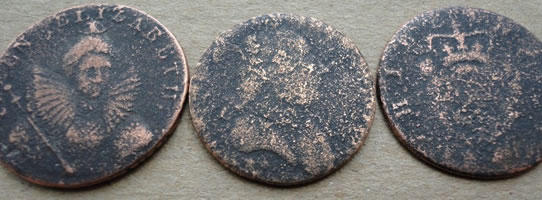
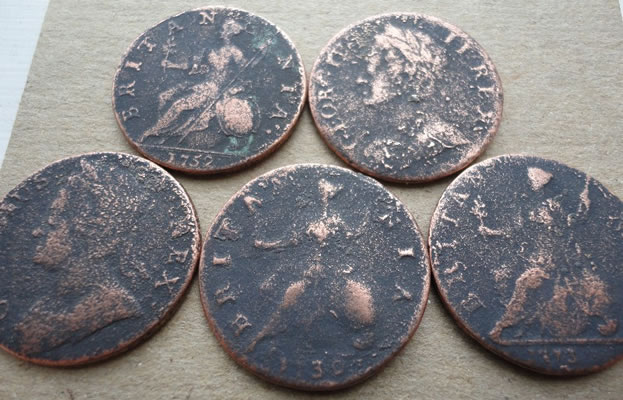
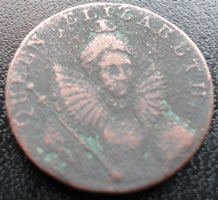
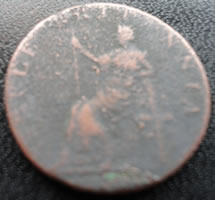
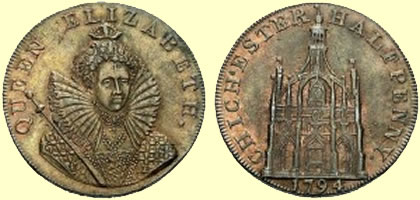

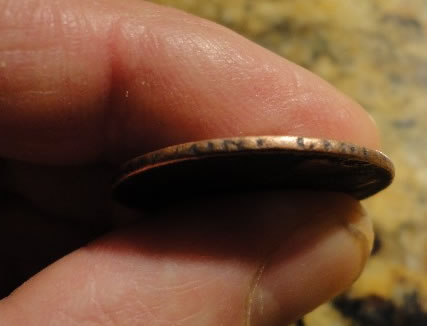
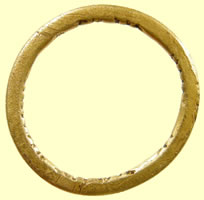
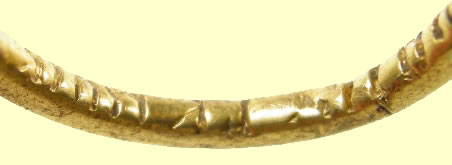



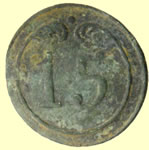


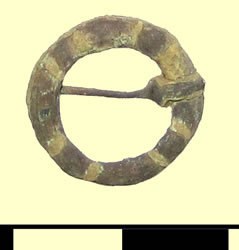


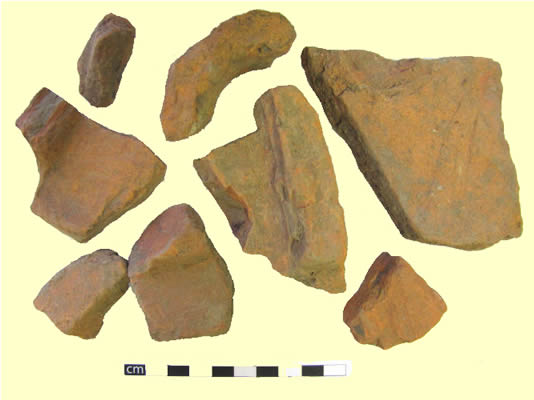

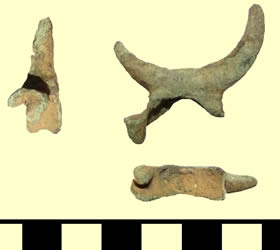


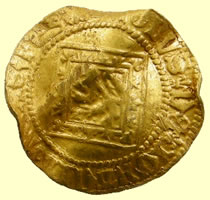
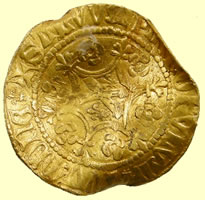



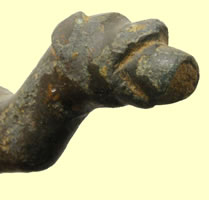
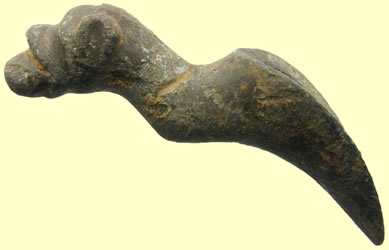

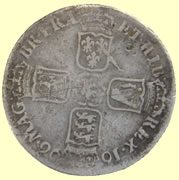
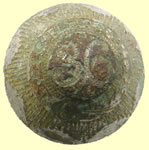
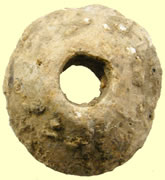
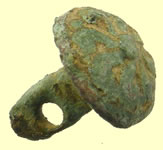
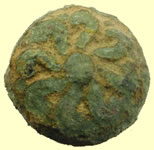




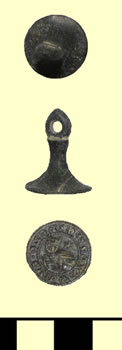
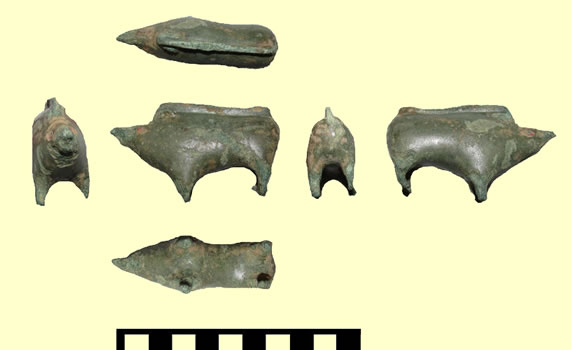
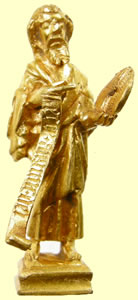

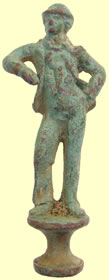


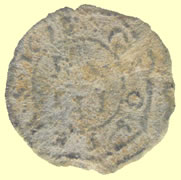
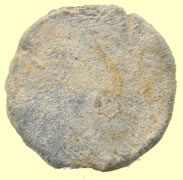
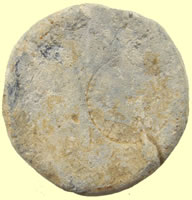
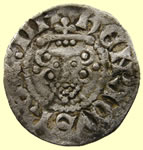

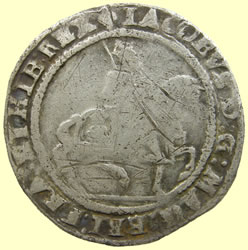
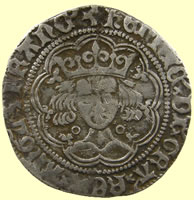
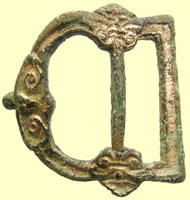
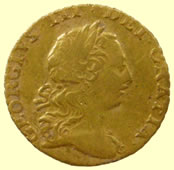
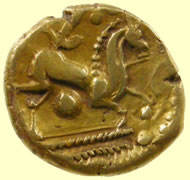
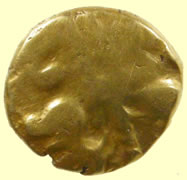



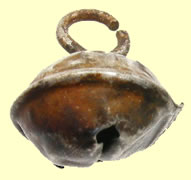


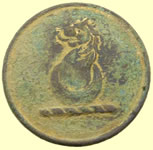
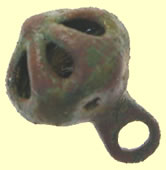


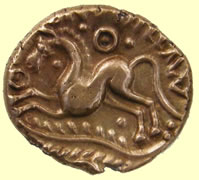
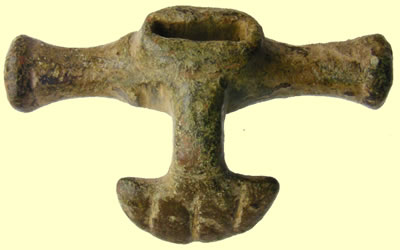
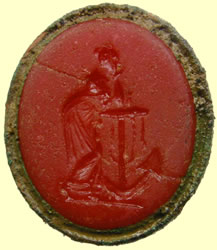
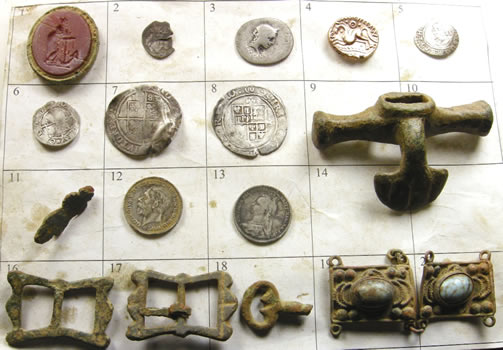
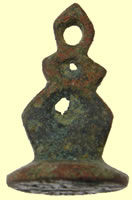
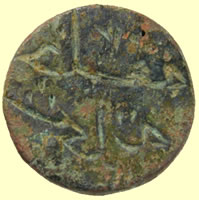

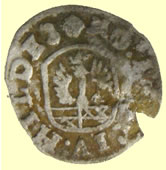
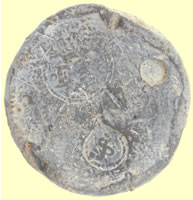
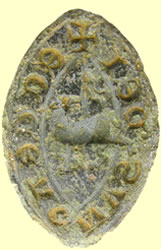
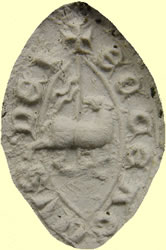

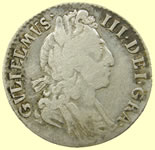
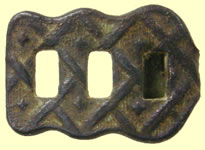
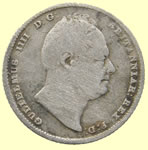
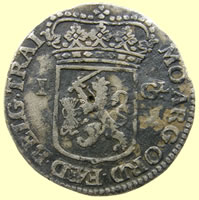

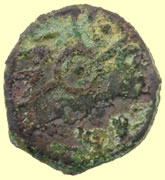
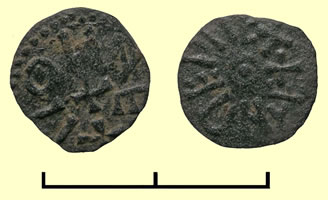
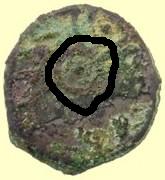
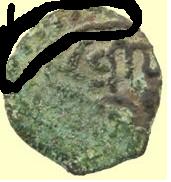
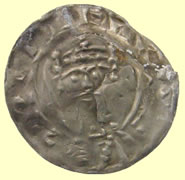

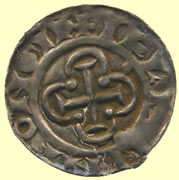
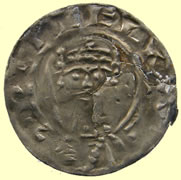
.jpg)
.jpg)
.jpg)
.jpg)
